The Traditional African Safari For Photographers

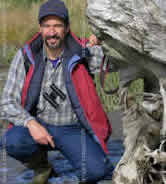
Dr. Palazzolo is a friend and a colleague and I’m delighted to introduce him to you once again in this column. His Antarctica special went over really well and many enjoyed it. Dr. Palazzolo
is an avid traveler, exotic animal veterinarian, and a wildlife conservationist. He teaches digital photography workshops on his exotic trips to Antarctica, Africa, South America and Alaska. Some time in the future I hope to include him in
one of our Thailand workshops so the participants will benefit from his knowledge and experience as well. This is the first of a two part comprehensive series on Africa which covers most every aspect of an African Photo Safari you could think
to ask. You can provide feedback to Dr. Palazzolohere, or visit his website.
(Please allow a few moments for this page to load)
African Safari
An African safari (safari is a Swahili word for “overland journey”) is a once-in-a-lifetime dream vacation for many people. I have
been on 5, with number 6 tentatively planned for February of 2011. The dozens of people accompanying me on many of these trips have increased my knowledge of what makes a trip memorable and worth the time and money. I would like to share this
personal experience for those that are thinking of going on their own safari.
On my first trip to Africa in 1986 I went to the Serengeti. I went by myself and booked the whole trip via fax on a reference for a safari company from one of my vet school professors.
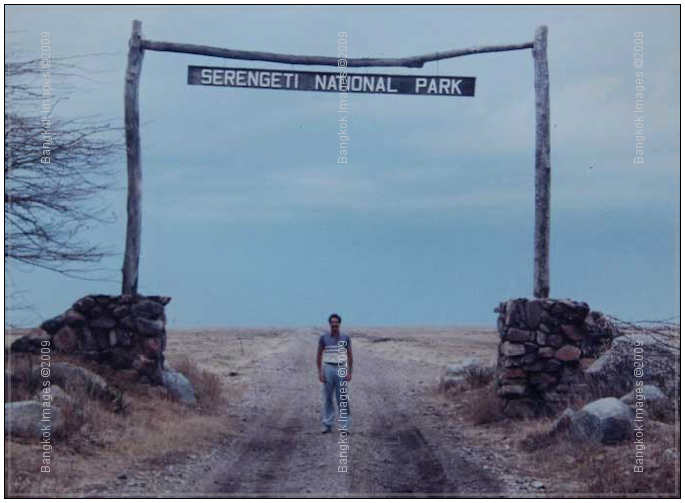
If you are thinking of going do not delay. Spectacles like the timeless wildebeest migration and the associated predator-prey relationship are changing, and might not be around in the near future. The burgeoning human population that needs firewood, water,
and food is encroaching upon land that supports African wildlife. Go now while the magic is still there.
The L A Times published good and timely articles on this topic this week. The Times also published an article on the Jouberts, pre-eminent wildlife photographers that predict lions will become extinct by 2020 if we do not act now. I will give you a link
to these articles at the end of this page in the “Further Reading” section.
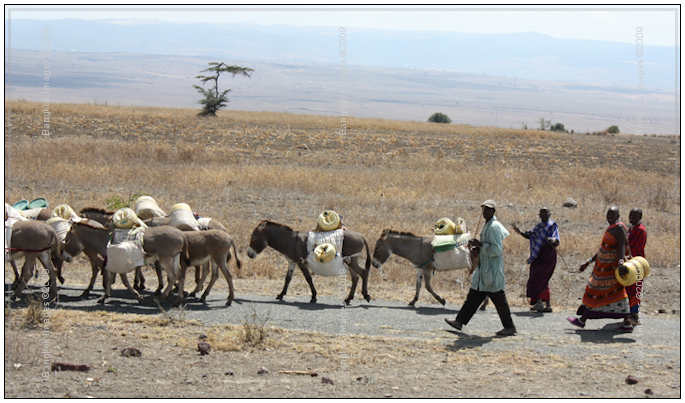
These farmers taking their mules to get water are walking through a wildlife corridor, a common scene
Rebel XSi, SS 1/800th, Av, ISO 400, f/8, Canon 18-55 mm f/3.5-5.6 IS lens at 55mm
Since this is a photography forum I am going put an emphasis on a photographic safari, which of course most are. It is geared towards beginning and intermediate photographers, but hopefully photographers of all levels will get something out of it. I will
limit my advice to personal experiences that are consistent over several trips and also what I learned from my guests, the guides and local people.
Most of my pictures (I am only showing a few of the thousands I have) will be from these safaris, with a smattering of pictures from other trips and some of my guests to help emphasize a point. Here is
the link to my web site with more pictures in case you are interested after reading this article.
Those of you that have already been on safari to Africa might have had a different experience and might not agree with my impressions- viva la difference.
My Background
I have been taking photos on overseas adventure trips since 1986 and have covered all seven continents. I have even been to a small island nation in the middle of the Indian Ocean where the DoDo bird became extinct.
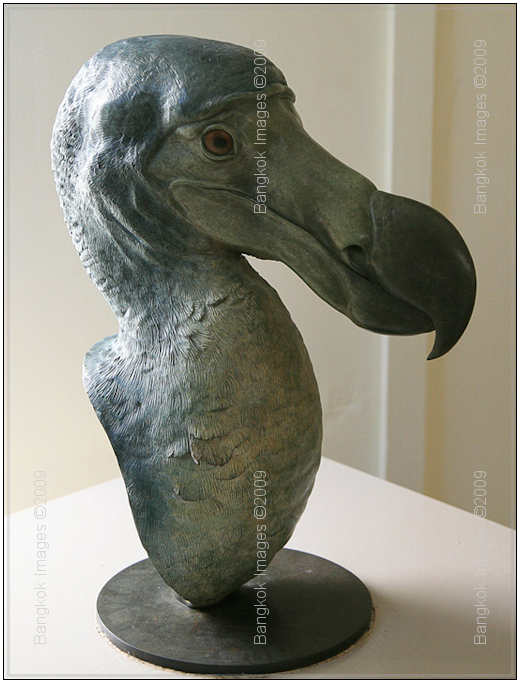
This is a Dodo bird statue I took in the country of Mauritius where it became extinct in the 17th century. It would be a shame to see the endangered wildlife in Africa have the same fate
As a veterinarian I have studied or worked with (and many times sedated and examined) wolves, mountain lions, Kodiak bears, rhino’s, orangutans, and African lions. My over 31 years of being an exotic
animal veterinarian have paid off with a familiarity and knowledge of animals that I am willing to share with everyone that goes on my trips.
On my Borneo trip in 1991 I arrived just as a group of babies that had been recently confiscated were brought to camp. Some of them were ill, possibly with tuberculosis, so I examined them.
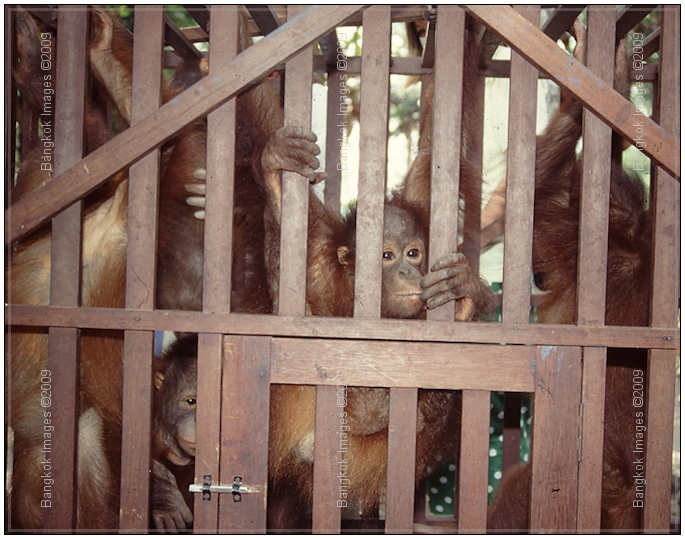
When you examine a baby orangutan you have to follow a certain protocol to their liking. Only after they have checked you out first can you proceed
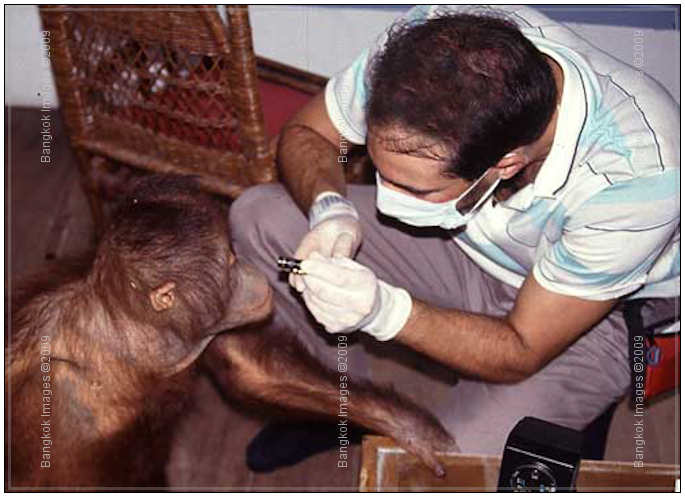
Your next step better be to get an assistant to help you because with 4 appendages that can grab from any angle you can get in over your head easily. You might even end up with an orangutan on your head if you are not careful
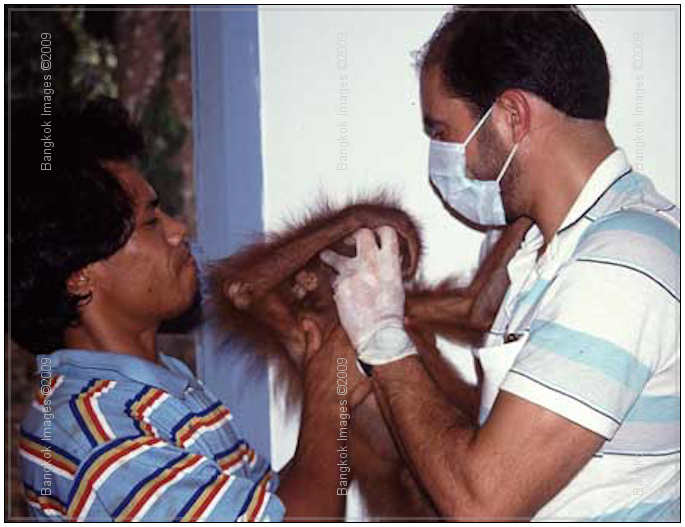
If you know what’s good for your sanity your next step after getting one assistant is to get another assistant
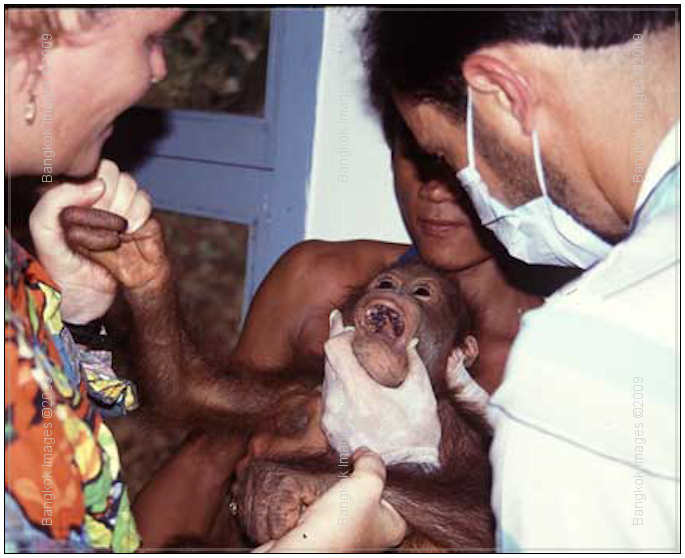
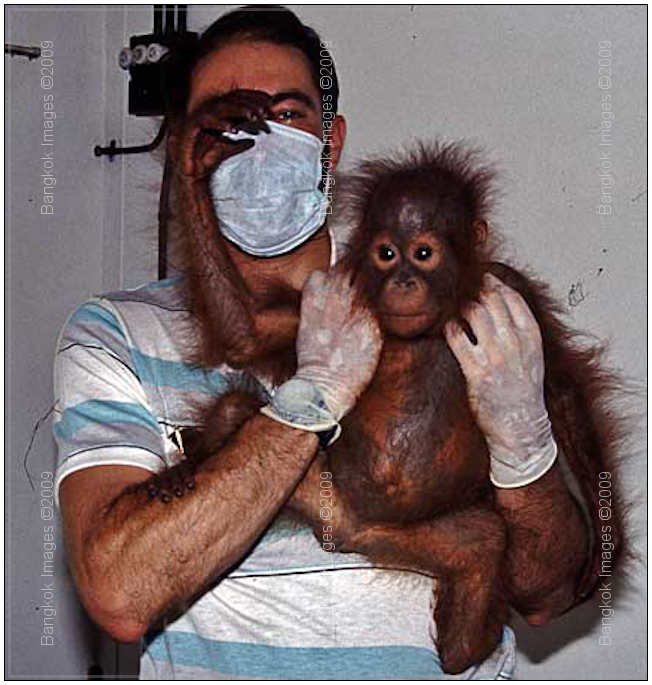
I think it is obvious who got the best of this exam
Another fun adventure was trudging through the snow of Idaho to sedate mountain lions for examination and blood sampling. It was part of a research project with Dr. John Landry determining the health of mountain lions that were in isolated patches.
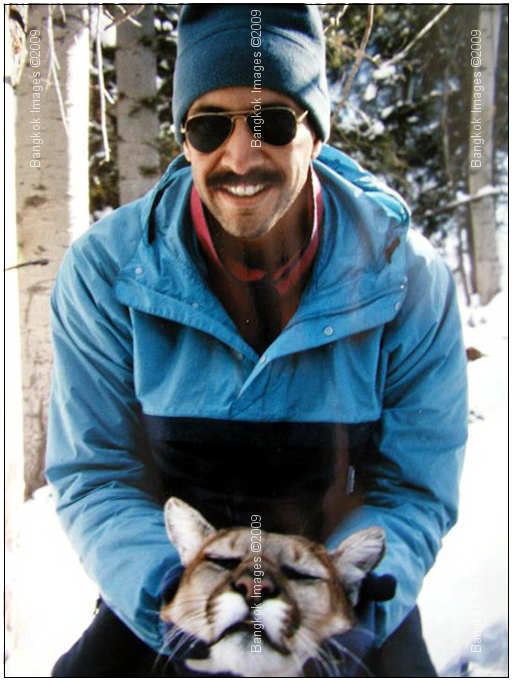
We sedated momma about one hour after the very enthusiastic hounds scented and treed her.
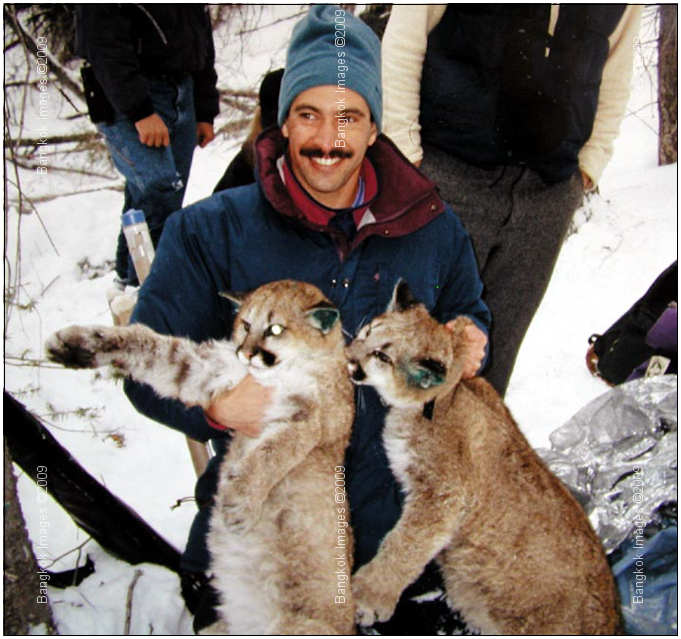
And these are her two babies we caught up with soon after.
In Kenya I helped a full time veterinarian from the Kenya Wildlife Service to sedate, examine, radio collar, take skin biopsies and blood samples on a mature male lion. Their overall philosophy is hands off and let nature do what nature is best at. They
do intervene on rare occasion and help an injured animal, especially if it is a human induced injury.
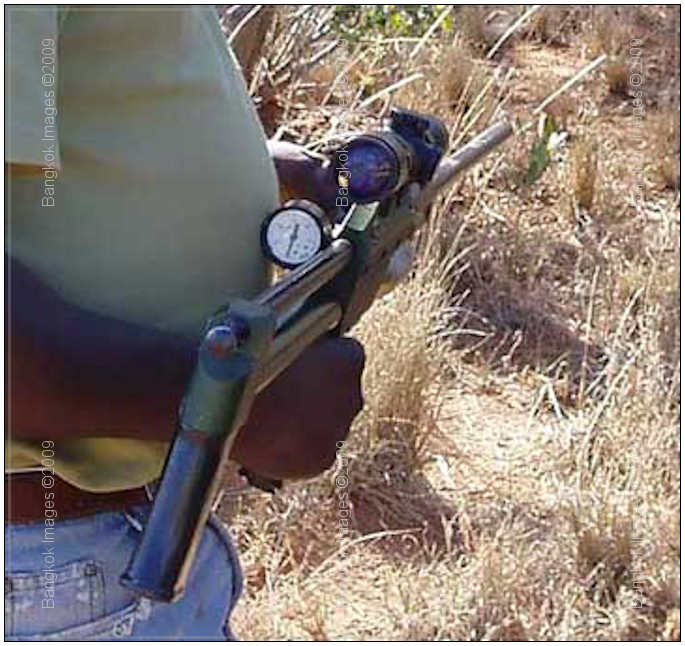
His equipment and drugs were basic by our standards, but he knew what he was doing with the dart gun
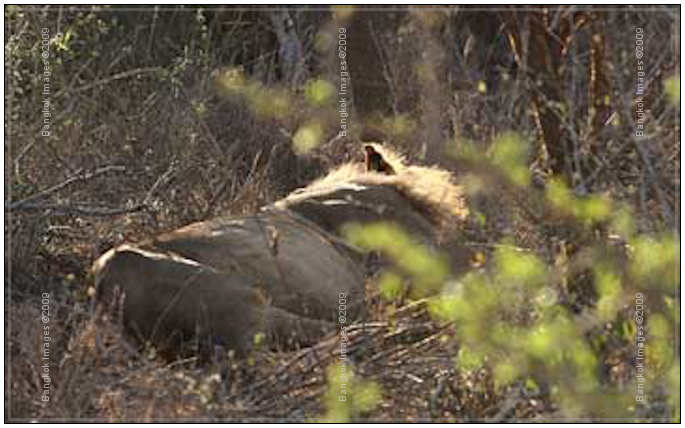
This is not a controlled environment, and you do not get out of the vehicle and approach a sedated male lion until you are 100% certain it is safe. Giving enough sedation to achieve this without overdosing in the heat takes experience when you are in
the field, and not in the relative luxury of the controlled environment in a veterinary hospital
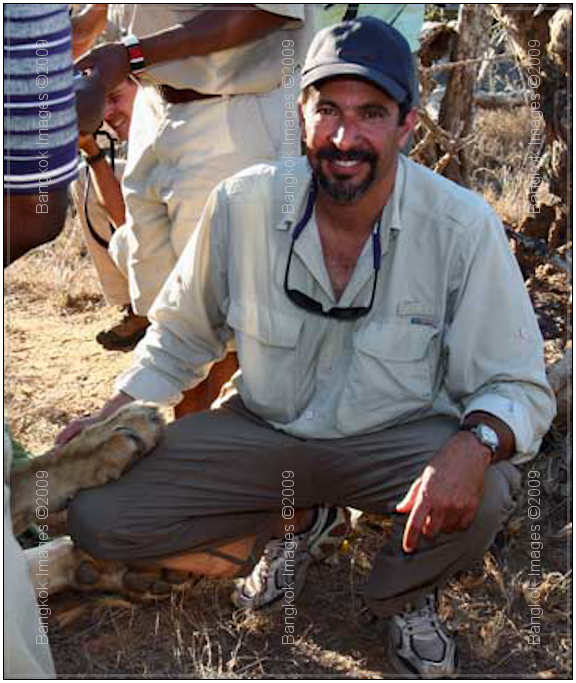
The beginning of my exam on the sedated lion
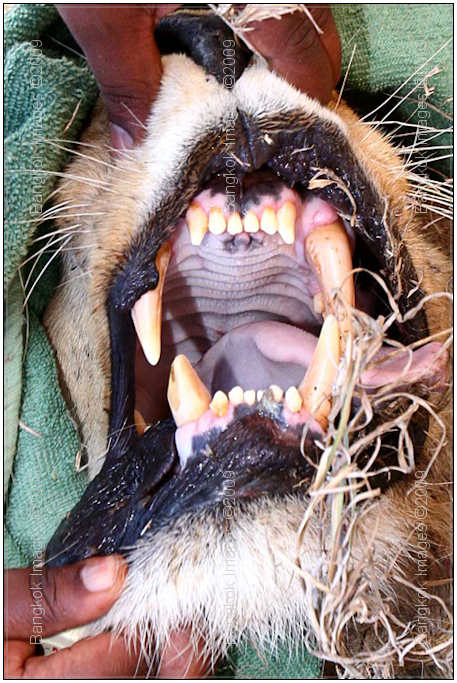
Close up of the action end. No braces needed yet
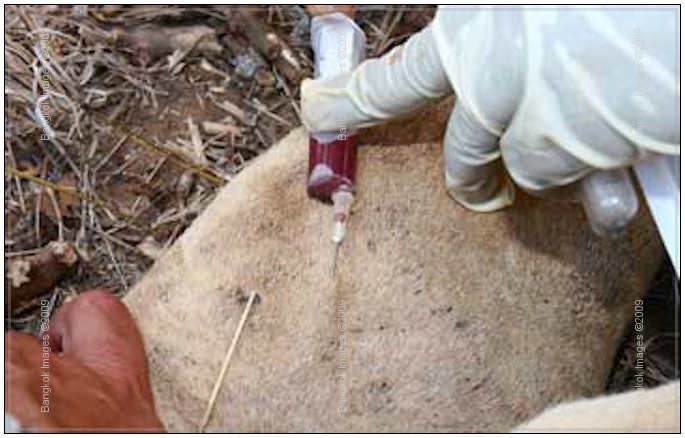
Taking a blood sample from a branch off the femoral vein
On this same trip we looked for lions throughout the night, sometimes with the help of telemetry. This gave me a great opportunity to learn about the nocturnal wildlife and even how to identify predators and prey by their eye reflections only. For an
interesting FYI, the structure at the back of animal eyes that reflects light, and that humans do not possess, is called the Tapetum Lucidum. And no, African predator eyes are not usually red when they reflect the light.
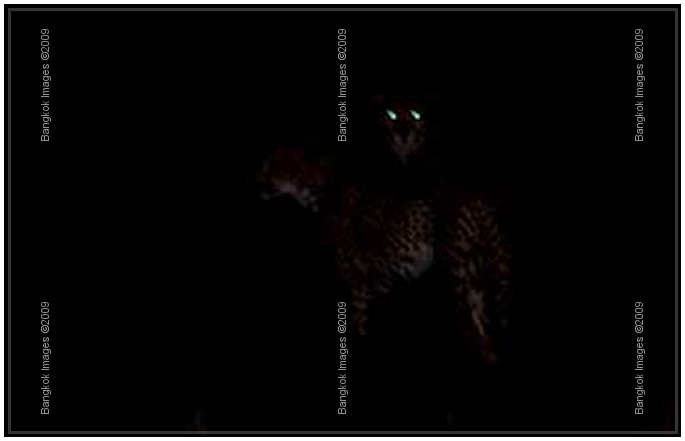
Here’s your chance- what species is this?
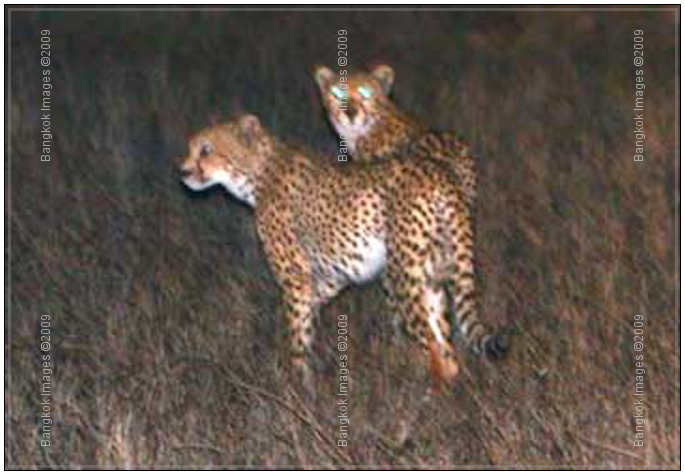
Its two cheetah
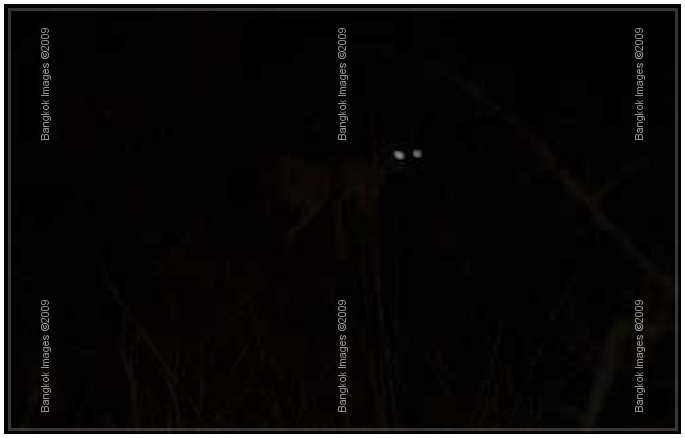
What about this one?
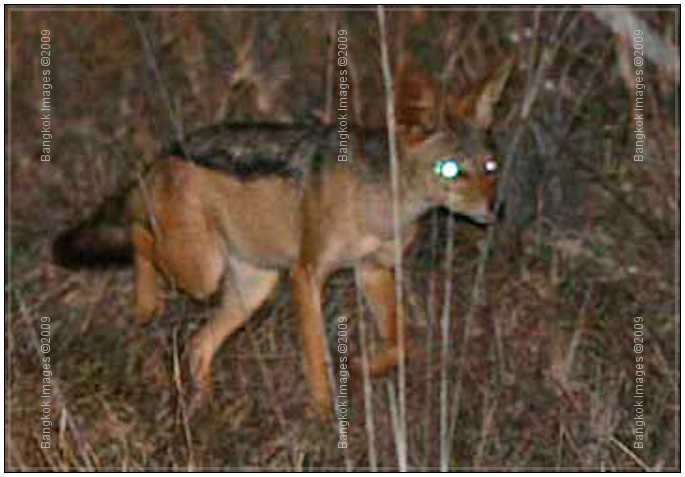
It’s a black backed jackal
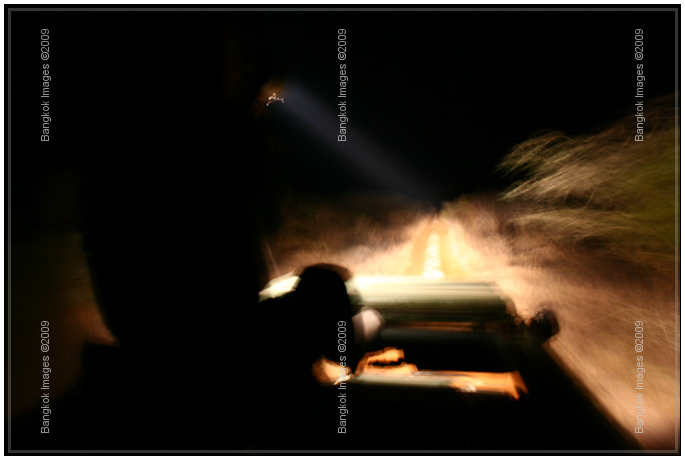
To find them at night we needed a high power light. We used the white light first to spot them in the distance while driving down roads
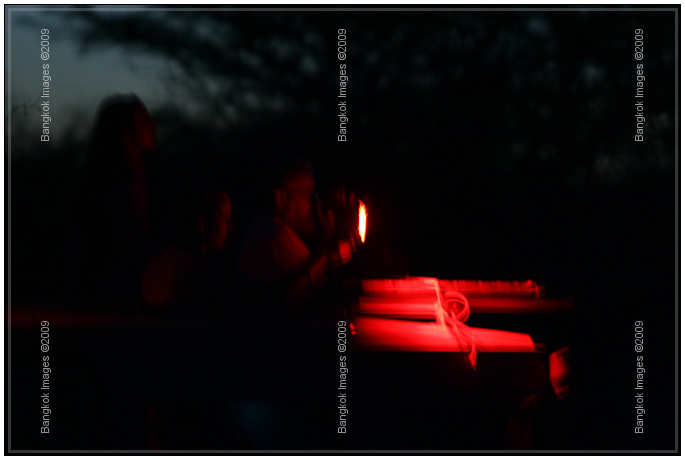
When we got up close we changed to a red light to minimize temporarily blinding them
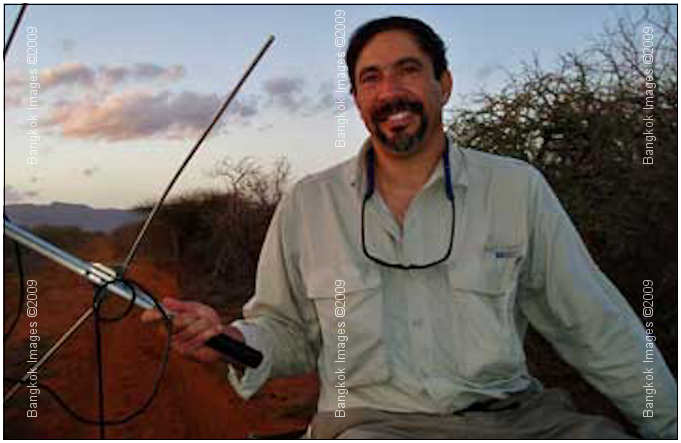
We used telemetry to find lions that were already collared
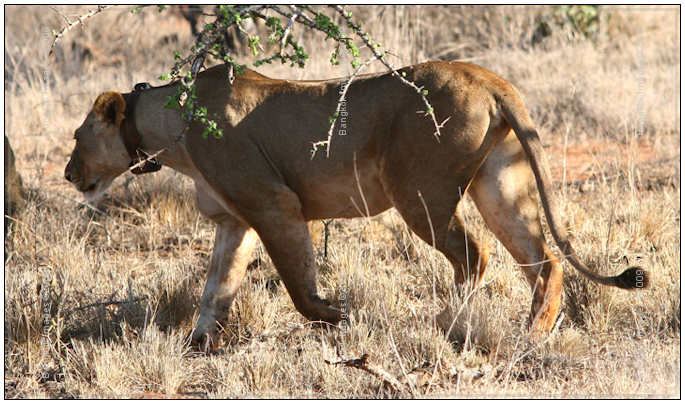
Searching through the night allowed us to find seldom seen nocturnal animals
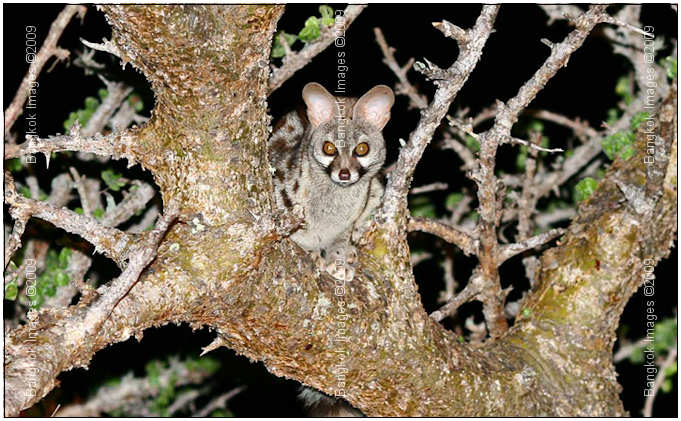
This is a Genet
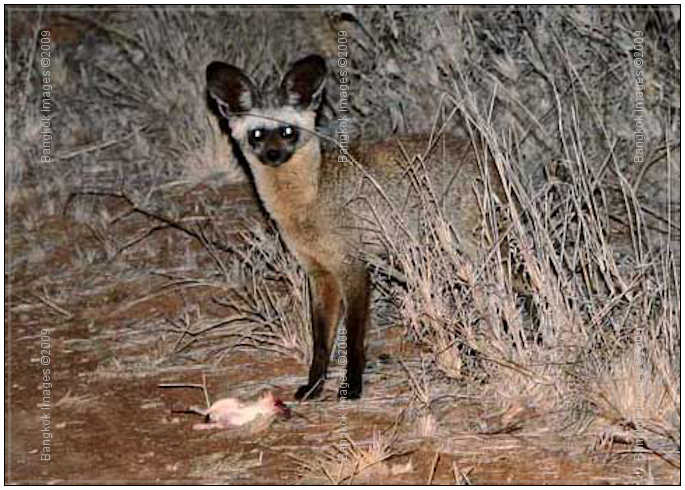
A bat eared fox late at night toying with a mouse
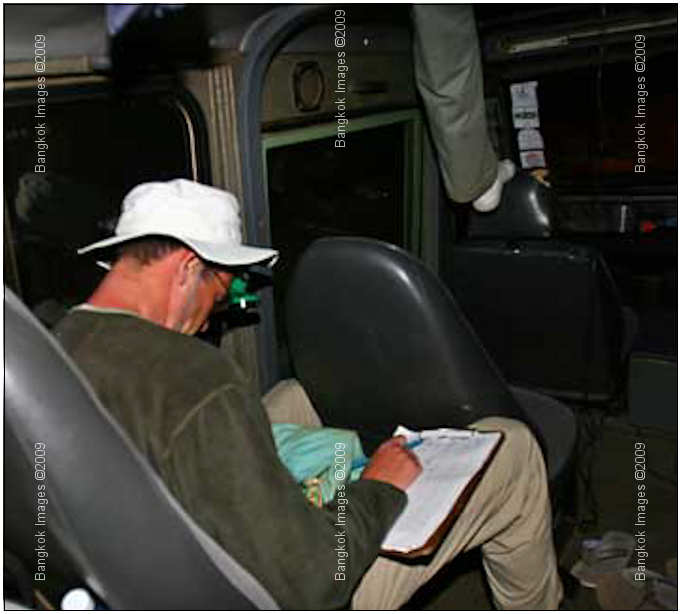
It was also grueling and hard to concentrate for those long hours of observation. The poor slob on the open roof reporting observations at 2 AM had no idea that the record keeper down in the car was fast asleep
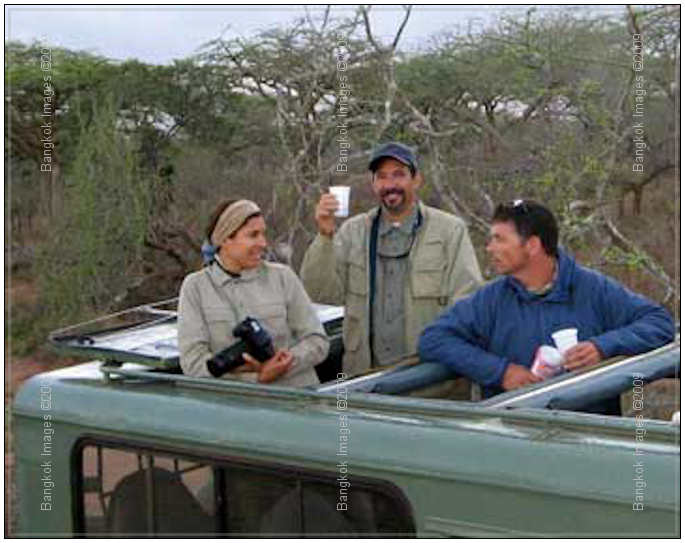
By 8 am we made a Starbucks run and were ready to head back to camp and sleep (for those of us that have not already slept of course)
In 1995 I walked many kilometers in Zimbabwe tracking Black rhino with an ant-poaching unit. There was a major war going on between the rangers and poachers. The government took it so serious that rangers were allowed to shoot the poachers on sight.
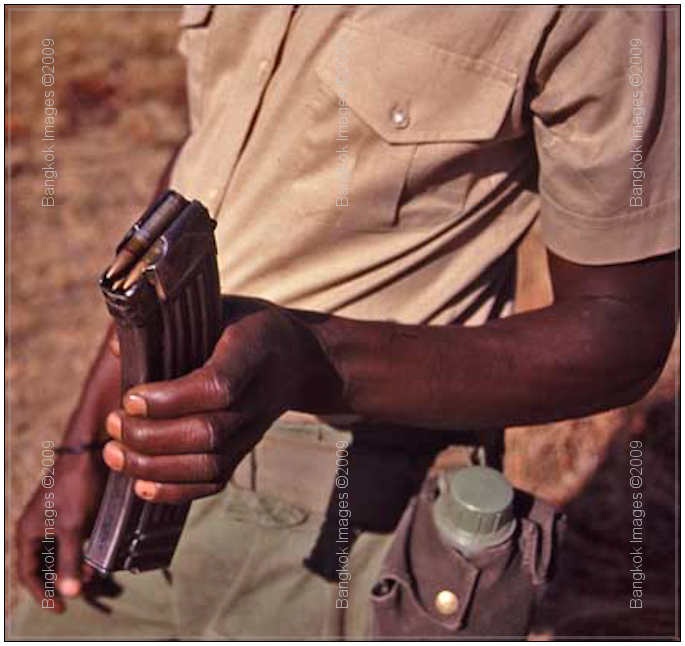
Our park ranger and guide named Zhou is loaded for bear (oops, I mean lion) in case we came across any dangers. This is a fully loaded AK-47 magazine, which is a great anti-poaching rifle, but not highly effective against dangerous and large wildlife
We tried to stay away from the poaching and concentrate on finding evidence of rhino, or if lucky, actual rhino. We were required to give all our rhino sightings over to the government. Too bad they sometimes sold this information to the poachers. Zimbabwe
is an awesome country for wildlife, unfortunately the political and economic conditions there have deteriorated so much.
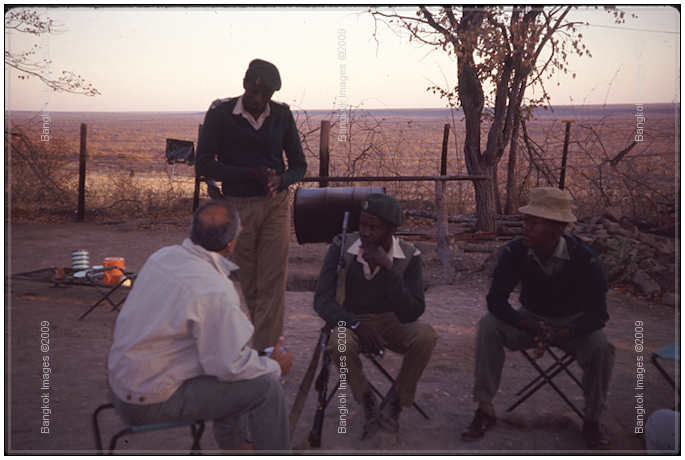
Each morning we met with the park rangers to decide the safest area to walk in relation to lions and poachers
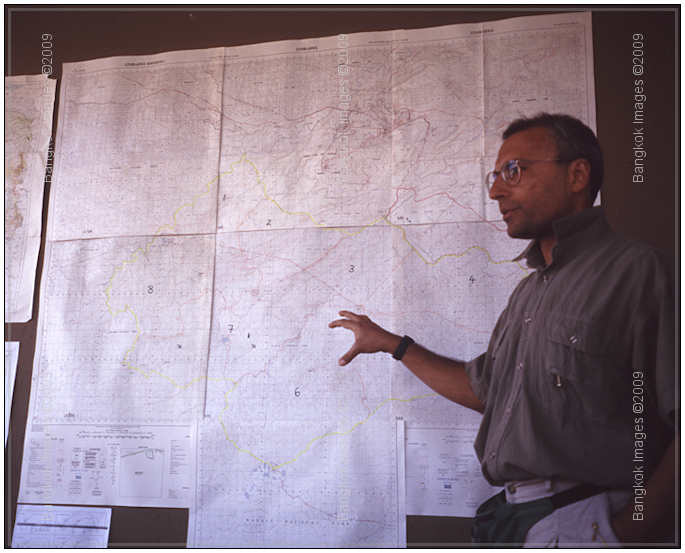
We were assigned a North-South transect to walk for the next 6-8 hours looking for any evidence of rhino
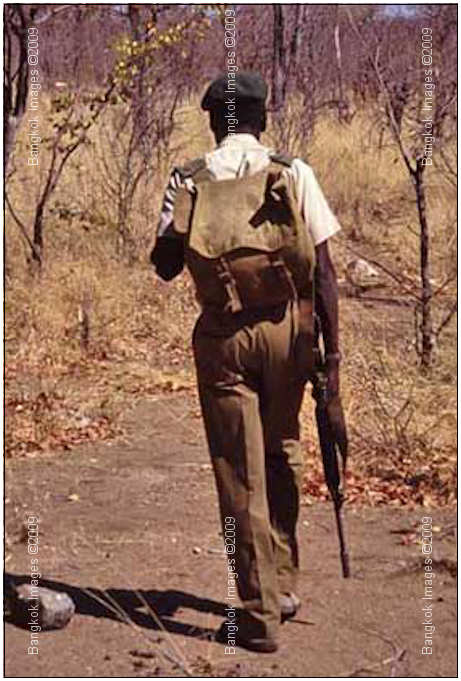
Once we received our assignment off we went, with at least 2 liters of water or we weren’t allowed to leave camp
To read a great African book in general, and to learn much more about African politics, Wilbur Smith’s “Elephant Song” is as good as it gets. I put it on my recommended reading list
for all my guests before they go, or even during the trip.
By the way, do you know the two primary uses for rhino horn? If you think it is aphrodisiacs you will be incorrect. This shows you how folklore on something that involves human sexuality is so compelling as to reign over fact.
This is a link to a reference showing rhino horn usage for making hilts for ceremonial daggers in Yemen. It makes for very interesting reading,
and Wiki shows the second use in TCM (Traditional Chinese Medicine) to treat serious fevers.
On all of my African adventures credit needs to be given to the guides and park rangers, because without their substantial help very little wildlife would be found. Keep this in mind when you book your trip. I will come back to this later due to its importance.
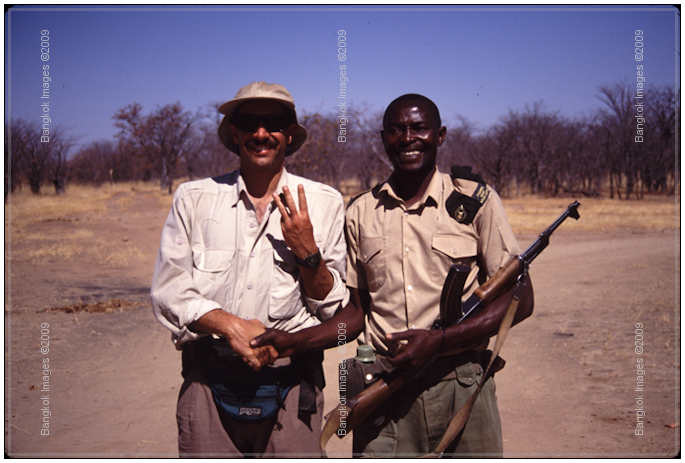
One day we sighted 3 black rhino, a huge success
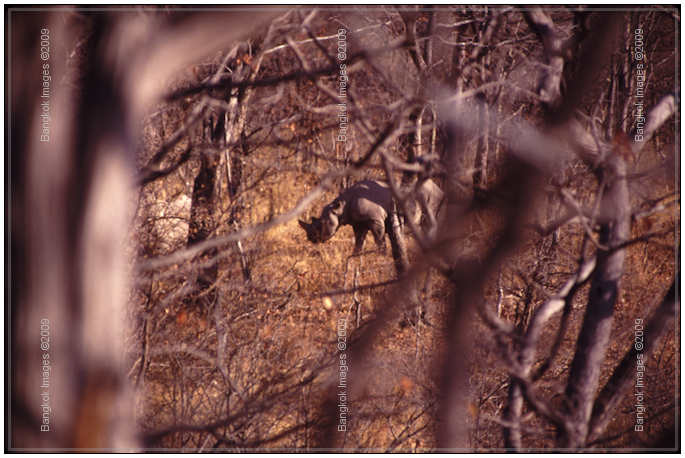
This is one of them off in the bush where no tourists are allowed
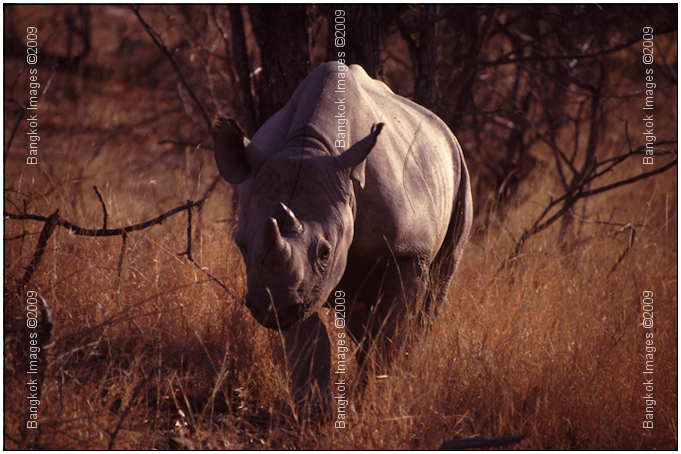
On a different day we followed one with telemetry. This is a calf that decided to turn towards us
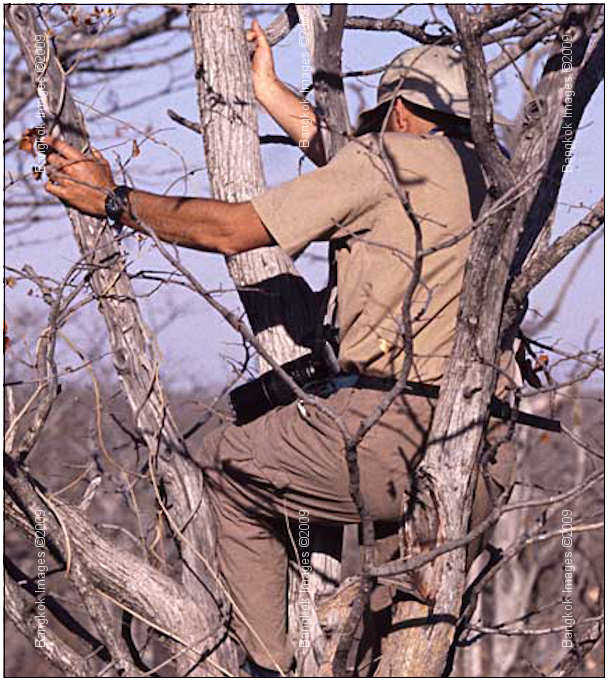
Its mother was with her, and as she approached the prudent thing was to get your ass in a tree asap. No worries if you cannot climb, the guides will literally push you up into the tree
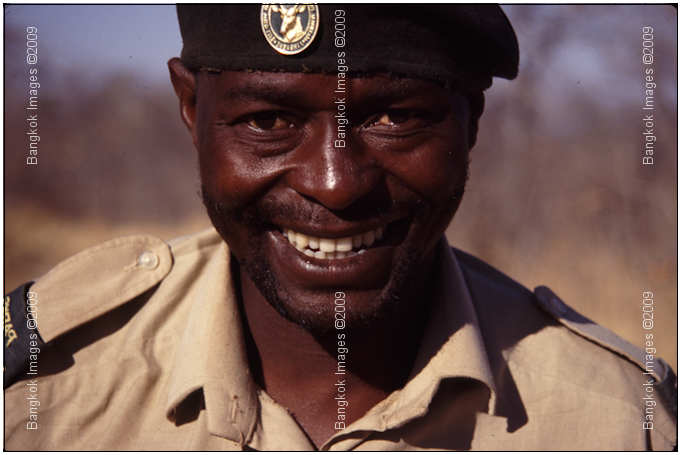
The smile on Zhou’s face when I gave him a Swiss Army knife for finding those 3 black rhino shows how valuable this gift is. Notice how nice his teeth are? This is a rarity in Africa
Now I pretty much limit my personal safari’s to taking my animal hospital clients, friends, and fellow veterinarians. My goal is for them to have a great time and get the photos they want. If they enjoy themselves then I enjoy myself also. Its
more fun to me to see a smile on their face when they see something interesting, or snap away at what interests them, than for me to get another photo to add to my Lightroom catalog.
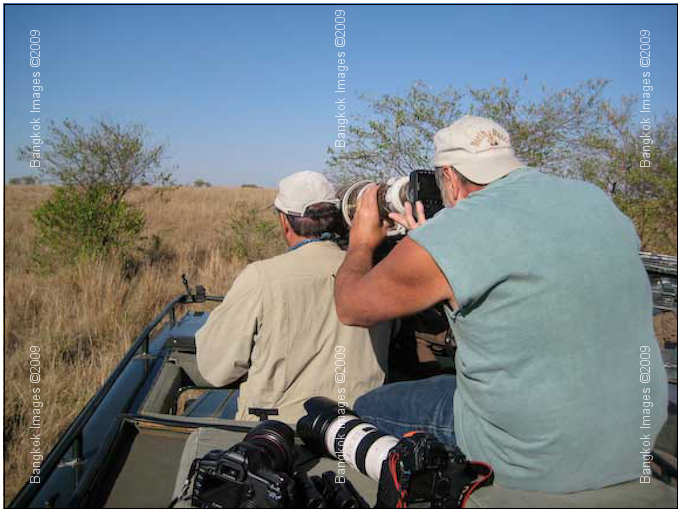
I would rather steady my 500 f/4 on my shoulder and help one of my guests than take my own photos usually (you will learn the exception later)
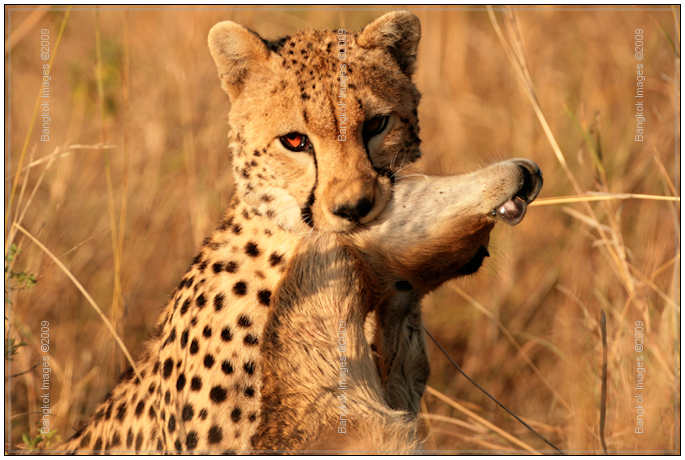
With my help aiming this 10X lens at this nearby cheetah Phil was able to finally find the cheetah and nail it
Rebel XTi, SS 1/640th, ISO 200, Av, f/5.6, Canon 500 mm f/4 IS

When you give amateur photographers access to professional equipment you need to be prepared to help them often. Its surprising how many times you have to remind them to focus before they shoot
My long-term photography goal is to become a member of the International League of Conservation Photographers. Their wildlife photography is unsurpassed. I have to postpone this goal for a while because I enjoy veterinary medicine too much.
Safari Options
Most African safaris occur in Kenya, Tanzania, Botswana, Zambia, Uganda, Rwanda, Namibia, and South Africa. I am going to narrow my advice to those people going on a safari to East Africa, namely Tanzania and Kenya, and arguably the best safaris to go
on when you consider cost and quantity of wildlife. The vast amount of wildlife that you will encounter are habituated to the vehicles, making observation and photography more convenient.
Due to years of documentaries on TV some of us are conditioned to think of the Masai Mara (mara means patchy landscape) and the Serengeti (it means extended place) when we think of African wildlife. You won’t be disappointed if you make either one a priority on a safari centered around the wildebeest migration. Do you know the Swahili name for wildebeest?
Up to 2 million wildebeest, along with hundreds of thousands of zebra and gazelle, make this annual migration. It is one of the best wildlife spectacles on the planet, especially when you take into consideration all of the predators that depend on the
wildebeest for their survival.
In addition to the Masai Mara and the Serengeti all of the National Parks in Kenya and Tanzania, along with the Ngorongoro Conservation area, are great. You can even visit Oldupai (not Olduvai) Gorge where
Louis Leaky the famous anthropologist did his seminal work.
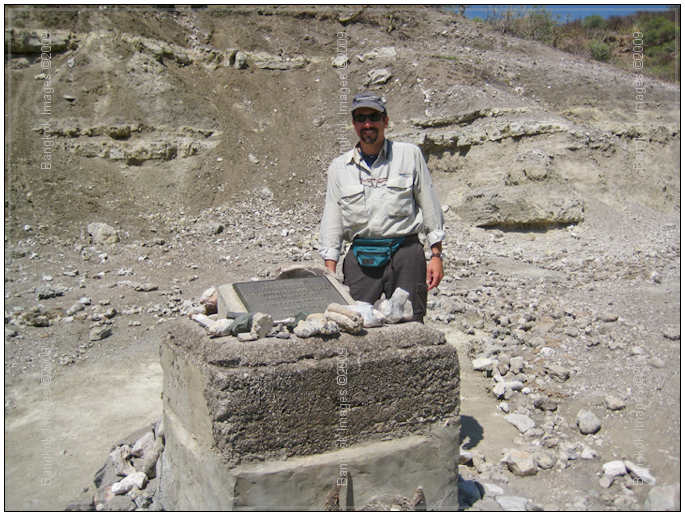
I went there twice in July of 2009. Fifty years and 1 day prior to my 2009 visit the Leakey’s made their famous discovery at this very spot
Most people go to East Africa in the summer, when the kids are out of school and grandma can take them on a trip as a memory of her when she is gone. This is a good time to go regarding the wildebeest migration.
Summer is not a good time to go if you want more of a personal experience. In the popular game parks you will see numerous other vehicles, and the hotels and camps will be full, so take that into consideration when planning. I prefer to go just after
Labor Day and try to get the best of all worlds regarding good game viewing and number of tourists. It all depends on what animals you want to see and the trade-offs you need to take into consideration.
During the summer you will find the wildebeest migration in both Tanzania and Kenya. Many web sites and books have detailed descriptions of where they will be at a certain time. This holds true most of the time, but not all the time. These animals do
not read our books and do what they want when they want. Part of it is a roll of the dice, and depends a good deal on the rains.
In the Serengeti they have a visitor’s center that gives you a perspective on the Serengeti that you have probably not seen on TV or read about in books or on the web. It emphasizes two things- the importance of the grasses and rainfall, and the
variability and fine tuning of the wildebeest migration.
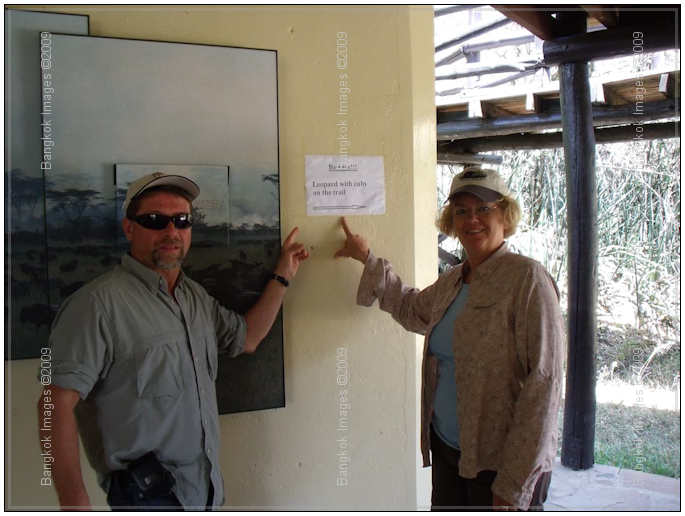
My guests at the visitor’s center with a warning about some other visitors. The sign says Beware: Leopard with cubs on trail
As the wildebeest run the gauntlet during their migration they lose tens of thousands of healthy, young, weak, and old, to accidents, disease, and predators. Even after this substantial loss the adults sometimes take their calves on a swim across a large
lake and keep crossing back and forth until the young drown.
This behavior doesn’t make sense after already experiencing such a substantial loss of life. It goes to show we do not know how nature operates sometimes. If you go to the visitor’s center make sure you watch the continual running video
that shows this in graphic detail.
In the early to mid-summer the Serengeti area is great for wildebeest watching. You can sometimes catch them crossing the Grumeti river in the summer when the crocodiles are hungry. I have been there at that time, and waited along with hungry crocodiles
for the thousands of wildebeest that were milling around just a mile from the Grumeti river to cross it. No such luck, so I have an excuse to go back.
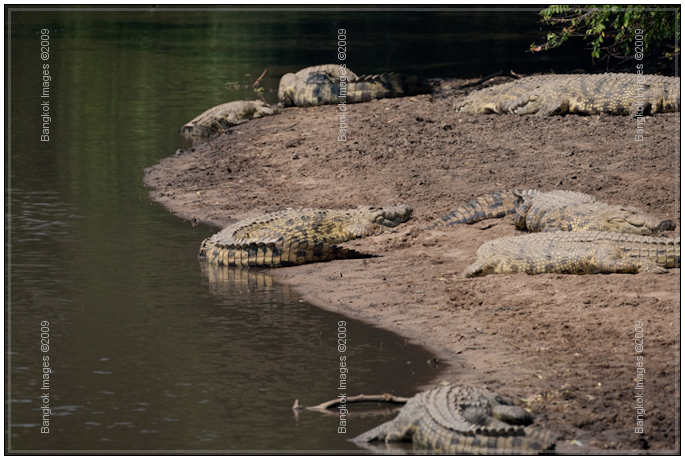
Lots of crocs at the Grumeti, but someone forgot to tell the wildebeests they were on the menu
Canon 1D Mark III, SS 1/2000th, Av, ISO 500, f/5.6, Canon 500 mm f/4 IS lens
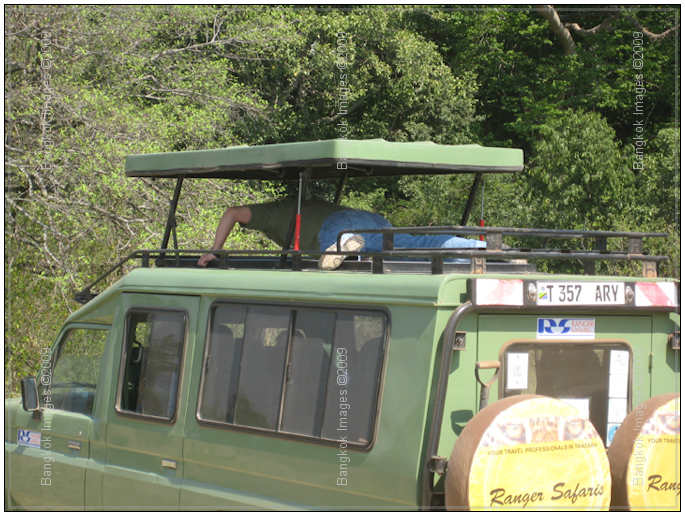
So what does a typical guest do while waiting for the wildebeests to show? He does push ups of course! He is from Las Vegas so I guess that explains it
Another good time for the Serengeti is February, between the rainy seasons, and when there are less people. During this time tens of thousands of wildebeest are calving in the southern part of the park in a two-week period of time. This brings out the
opportunistic predators and gives you a better chance of watching that timeless predator-prey interaction. This is where and when I plan on taking my next group in February of 2011. Details should be worked out in the next 3 months, and of course
everyone is welcome to join us.
As the summer transitions into fall the Masai Mara has fantastic wildlife viewing and gets a good part of the migration. You might catch the wildebeest crossing the Mara river in the summer (if they are there yet) when the crocodiles are hungry. My best wildebeest crossings have been in the fall, but by then the crocodiles have filled themselves and are not hungry. Again, no luck for me with those uncooperative crocodiles.

Some of them are big boys
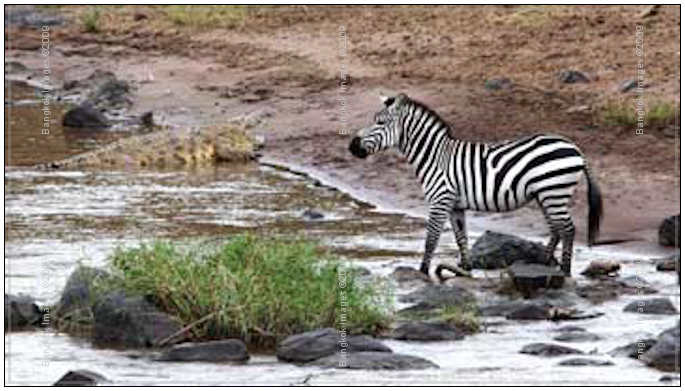
This zebra had no fear of crossing right in front of this crocodile in October
The guides in Tanzania tend to stay on the main roads and do not get as near to the distant wildlife as the guides in the Masai Mara. They want to keep the ecosystem as untouched as possible for the future. This means you might need longer glass for the
Tanzania game parks on occasion. Do not worry, Tanzania abounds with animals that will be just outside your vehicle.
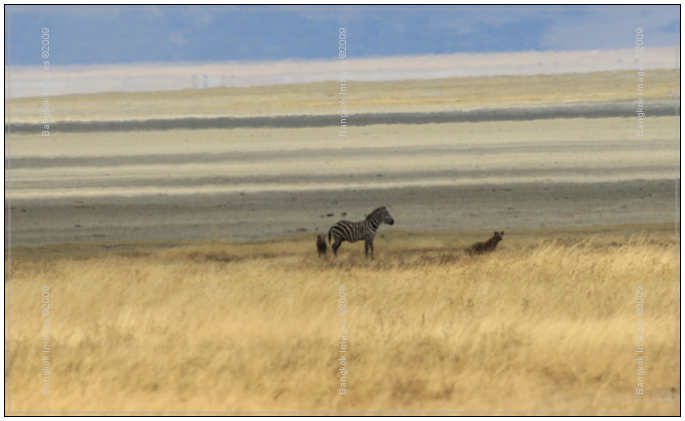
This is as close as the guides would allow to this doomed zebra trying to fend off the gathering hyenas in the Ngorongoro crater. Notice the distortion due to the heat waves.
Canon 1D Mark III, SS 1/2000th, Av, ISO 400, f/8, Canon 400 mm f/5.6 lens
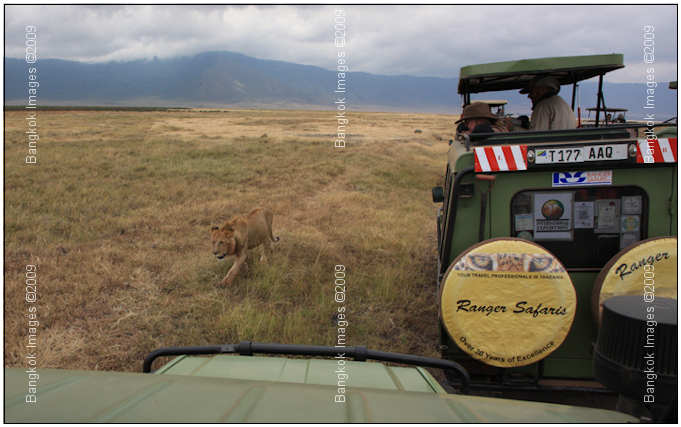
Same crater one mile away and things get more personal
Canon 1Ds Mark III, SS 1/800th, Av, ISO 640, f/8, Canon 24-105 mm f/4 IS lens @ 24 mm
I encourage you to visit a Masai village and learn about their fascinating culture. Make sure your guides take you to an authentic one in the bush where the leaders want to show you their culture and not just grab a few quick dollars. I had this occur
on one of my trips, and when I mentioned this to the guiding company in between groups they took us to a better village the second time. Make sure you bring antiseptic hand wipes because you will be shaking their hands and their hygiene is probably
not quite up to your standard.
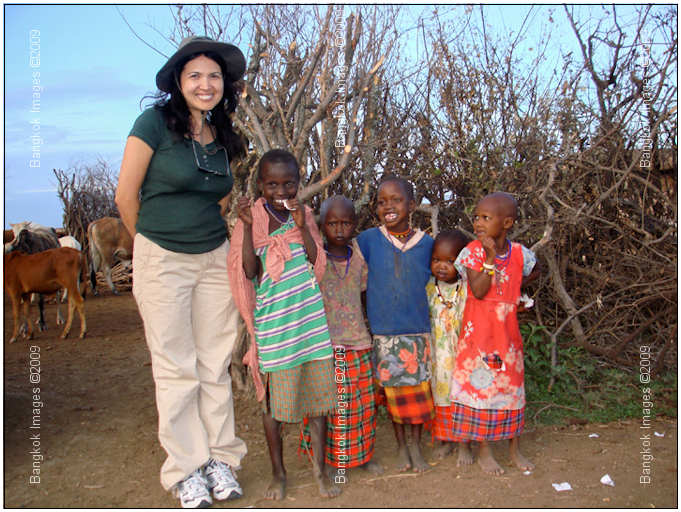
The kids are cute and they almost always have snotty noses and flies buzzing around them. This is the time to give them your gifts
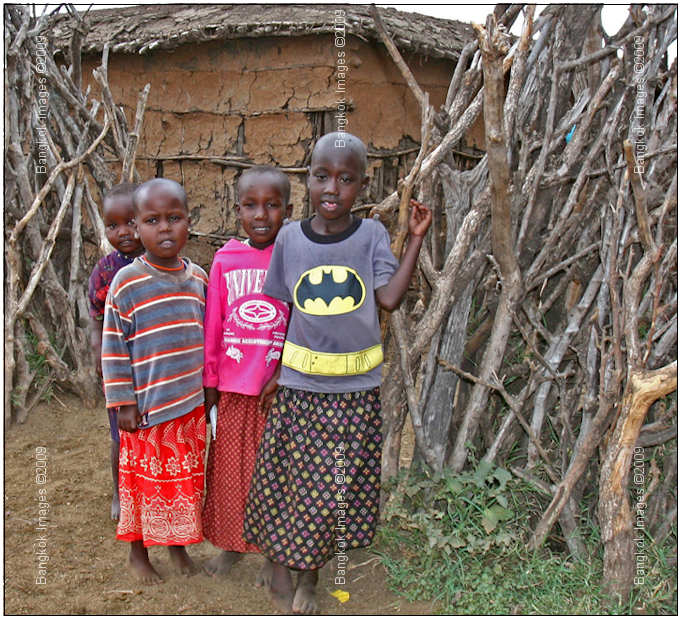
Sometimes batman makes an appearance
Airlines
Typical economy airfare from the U.S. ranges from $1500-$2500. Business class is the way to go if you have enough frequent flyer miles. They don’t care how much photography equipment you bring on board in Business Class. Book at the earliest time
possible, which in my experience has been 9 months prior, to see if you can even use those miles.
The flight to your first gateway city is up to 8-10 hours, then another 8-10 hours to Kenya or Tanzania. Cramming into your economy seat and looking at the front of the plane towards those people in Business class can make you wish you used those frequent
flyer miles for one of those seats on such a long series of flights.
Many Americans fly British Airways or American Airlines through London to Nairobi for the Kenya trips. I always set aside 1-2 days in London to rest, stretch my legs, and see the sights. Terminal 5, the new international terminal, is now open at Heathrow
and the bugs supposedly have been worked out. Even though things are smoother with the opening of Terminal 5 give yourself extra time for anything at Heathrow because it is a city unto itself and the number of travelers is mind boggling. Many
of these travelers are foreign and inexperienced and lines can be long and slow.
A common way to go to Tanzania is with Northwest (now Delta) or KLM through Amsterdam and eventually to Arusha. Amsterdam is a lovely city in the summertime and well worth seeing.
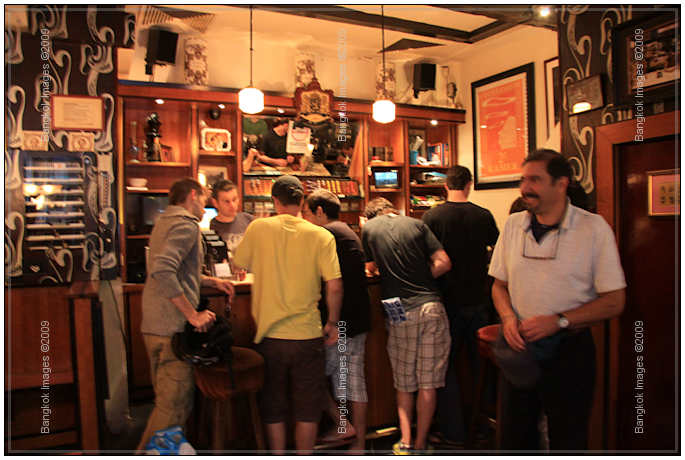
I know why you are interested in Amsterdam. They call them coffee shops and the menu of the different varieties of marijuana is almost endless (and potent). I only know this from word of mouth of course
Canon 5OD, SS 1/6th, Av, ISO 1250, f/6.3, Canon 17-85 mm F/5.6 IS lens @ 17 mm
Once in Arusha you are at the base of Kilimanjaro and can go to many different National Parks. If you are up to it climb Kilimanjaro. I did it in 1986 on my first trip to Africa. It was well worth it, but I would not do it again because the peak is over
19,000 feet. If you go book a trip that takes 5 days to get to the top. Your lungs and pounding head will thank you that you did not try to reach the peak in 3 days like my group did.
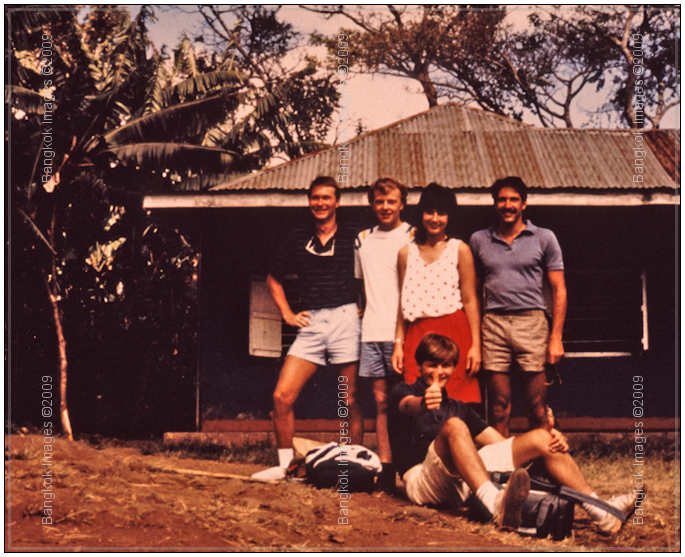
Here is my group, fresh and rested at the beginning of the climb
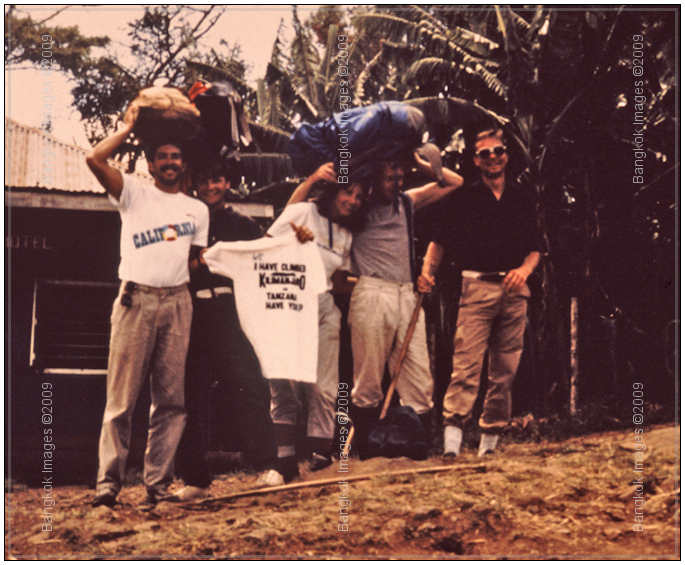
The same spot as above, just 5 days later when we returned from the climb. We are mimicking the porters who carried our bags on their heads all the way to 15,000 feet
While we are on the subject of airlines lets talk about baggage fees. First, there is no rhyme or reason sometimes on when they charge you. Some of my guests have been charged extra, while others with bags of a similar weight were not. Just assume they
are going to charge extra. My best advice is to be nice to the check-in person and schmooze them. I usually ask them how their day is going, comment on how they get all those people checked in so efficiently, and thank them whenever I can.
Maybe I am lucky, but so far no problem for me with extra baggage fees or taking computers and camera equipment on board for the overhead bin. Many pro photographers check their equipment out of necessity because they are bringing lots of equipment and
have no choice. I like to travel light, and prefer my camera equipment be kept far away from those gorillas loading and unloading the checked bags.
My first carry-on consists of my Canon 500 mm f/4 IS in the Glass Taxi. I pad it extra well and put a few miscellaneous items in the dead spaces. My Tamrac 5263 rolling case holds my computer, camera bodies, battery charger, converter, binoculars, flash,
a lens or two, batteries, etc. They both fit in the overhead bin of a commercial airliner. I can probably fit the Glass Taxi under the seat in front of me if necessary.
If I ever do have a problem with an airline agent with a “tude” I will take the computer out and put it in a very thin backpack I bring for just this problem. I would put the computer under
the seat in front of me. One lens and one camera body go in my jacket pockets, along with passport, money, and important papers. I can hang another camera body and lens around my neck, and eventually roll this camera and lens in my jacket and
put it in the overhead when I sit down. I will put the Glass Taxi in the overhead bin also. In business class they don’t seem to care and have storage for most anything you bring on.
If you are flying on a small plane within Tanzania or Kenya you will have a strict baggage weight limit for this flight. I have flown out of Wilson airport in Nairobi twice when going to the Mara, once they charged me a little extra, the other
time they did not even weigh my bags. If you go through Wilson airport put as much stuff in your pockets and lighten up the bag before they have a chance to weigh it.
On my last Tanzania trip we drove to the Serengeti and took a one-way flight back to Arusha on a small plane. Our itinerary was very specific about baggage weight on this flight, limiting it to 33 pounds total. I would like to see any serious photographer
make that limit with clothes and equipment. As it turns out we flew out of a bush airport, there were no scales, and the pilot did not care one iota, so don’t sweat this one.
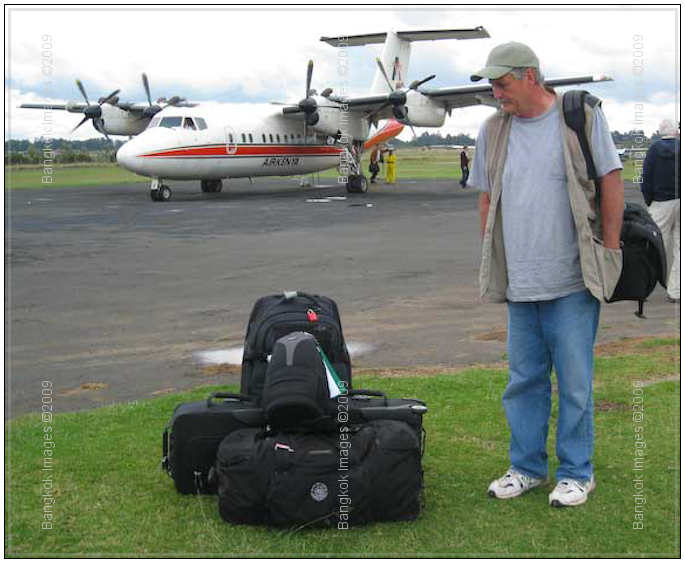
Don’t sweat it, unless of course you try to get this much luggage on a bush plane
Do not travel in the airplane or other means of long distance transportation with the lens attached to the camera. One person did on the Tanzania trip, and when her camera bag happened to have another bag tossed on top of it the lens mounting bent and
her 70-200 mm became non-functional for the duration of the trip.
On my first trip to Tanzania in 1986 we had to identify our luggage on the tarmac before they put it on the airliner. It was their security measure since they had no x-ray machines then.
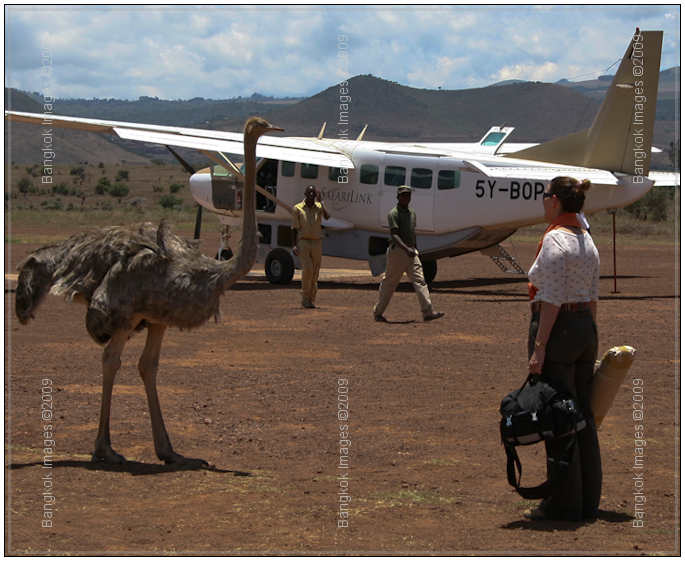
Funny things can happen at bush airports. This is a case of wildlife when least expected. Bags are packed and we are ready to load, and here comes the ostrich. Lucky someone got it. I will be harping on this “wildlife when least expected theme”
until you are sick of reading it
Medical Information
The best source of vaccine and disease information on precisely where in Africa you are going is the Centers for Disease Control and Prevention. If you go to a travel nurse or doctor for your vaccines they will probably use this source.
Be sure to get a Yellow Fever vaccine. Now is also a good time to get that tetanus shot updated (its every 10 years). Whether you get cholera and hepatitis is up to you. I get Rabies vaccines every 5-10
years due to the prevalence of Rabies in foreign countries and the added exposure to Rabies due to my profession.
Almost everyone brings along anti malaria medication. The 2 most common are Lariam taken weekly and Malarone taken daily. You can even use Doxycycline. At the Indian Ocean coast (near Melindi and Mombasa) there are many mosquitoes. If you stay at the 3-5 thousand foot elevation found in many of the National Parks in East Africa you will encounter few mosquitoes. Some people have vivid and even unpleasant dreams with anti malaria medication, especially
Lariam. Test before you go on the trip to see your individual reaction.
For diarrhea I bring along Pepto-Bismol. If I have a problem I eat very little to nothing for the remainder of the day and take the Pepto-Bismol. By the next day I am good to go. My veterinary colleagues tend to bring along a veritable pharmacy with them
just in case, especially Flagyl for diarrhea. I think it is overkill and would only use this medication, and the Ciprofloxacin that is commonly prescribed for these trips by your travel doctor, only if I have been ill for several days and my condition
is progressing.
Make sure you take extra of any prescription medication you must have. On my trips medical evacuation is included in the price. If you have a serious problem flying doctors will get you out of the bush, off to basic medical care, and then transferred
off to the international airport to either Johannesburg or London for sophisticated medical care.
I saw this in action when rafting the Zambezi river in Zimbabwe. A guest fell out of the raft and broke her leg. A helicopter was in the gorge within the hour and she was flown to Harare. The next day she was in London.
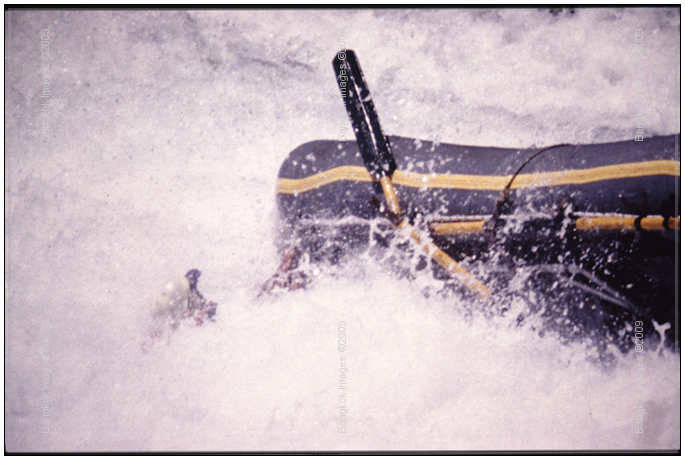
This was the crash that broke her leg (and broke the oar). That’s me hanging on to the rope. The lady that broke her leg did a no-no. We were instructed not to brace our feet in the bottom of the
raft if we flipped, just let it happen. She paid a price for not following instructions. If you want a thrill when you visit Victoria Falls raft the Zambezi.
Paperwork
Make sure your passport is good for at least 6 months after you return. I have mailed my passport to the proper embassy in Washington D.C. several times for my visa and never had a problem. Go on the web site for your desired country and follow their
directions in detail. I send my passport return receipt requested so I know when they got it and so it can be tracked. I do this way in advance in case there are any problems, which so far have been none. Your travel agent will give you information
on a private company that will do this for you. I do not think they are worth the added price for something you can do readily on your own.
Many people successfully get their visa on arrival in Tanzania or Kenya. It is easy to do and less expensive than the other methods. Keep in mind this is another line to wait in after a long series of flights. If you are traveling in a group make sure
everyone gets their visa the same way. It can be frustrating to get your visa before the trip, sail through customs, and then sit on your bags while your travel companion is still in the visa arrival line.
Speaking of arriving at the airport, I wish I had a picture of the modern and sophisticated Boeing 777 sitting on the runway at Kilimanjaro airport with the very basic Kilimanjaro terminal in the background. It’s a study in contrasts. That’s
another picture to add to my list of future shots. Due to security concerns be careful of shooting pictures of airplanes and airports in African countries.
I keep a copy of my itinerary and passport at home with someone trusted and also in my checked bag, in addition to the original, which I keep on me. I bring between $500 – $1,000 dollars on a typical safari. I bring extra in case one of my guests has
a problem. They just pay me back when I return home (at 10% interest per day).
Bring new bills, and do not bring bills greater than $20 because the Tanzanians are very fussy about accepting big bills and older bills due to counterfeiting problems years ago. I go to my local bank at home and exchange $25-$50 prior to the trip in
the local currency of my destination country. Most flights from London and Amsterdam land in East Africa at night. The day after arrival, and before you head off on safari, have your guides take you to a local currency exchange bank
(Barclay’s in Tanzania gave the best rates on my last trip) for a better exchange rate than the hotels.
Europe is very expensive in general, and with the exchange rate even more so for us Americans. If you are staying there for a few days make sure you have a realistic budget for your European jaunt.
I bring one Master Card and one Visa credit card- American Express and Discover are not commonly accepted. Keep in mind it is not uncommon for a place that takes credit cards to be unable to process your transaction because of some problem. Cash is king,
and even if you do not have the local currency many vendors and shops accept the US dollar. Very few people use traveler’s checks. I usually do not bring my drivers license unless I anticipate driving, which has never happened on a safari.
I always tip the guides in US dollars.
Plan on tipping the safari guides at least $50 total for your trip. On my typical ten person safari there are 3 guides that split the $500 tip. Your travel agent will give you a recommended protocol. Many people give more because they are so satisfied.
Set aside money for miscellaneous tips, especially for the wait staff and porters at the tented camps. Keep in mind the people in these countries might only make a few hundred dollars per month, if they are even working. Many of them do not even
have the money or the electricity to charge their cell phones and have to charge them at their place of work or at cell phone charging booths along the road.
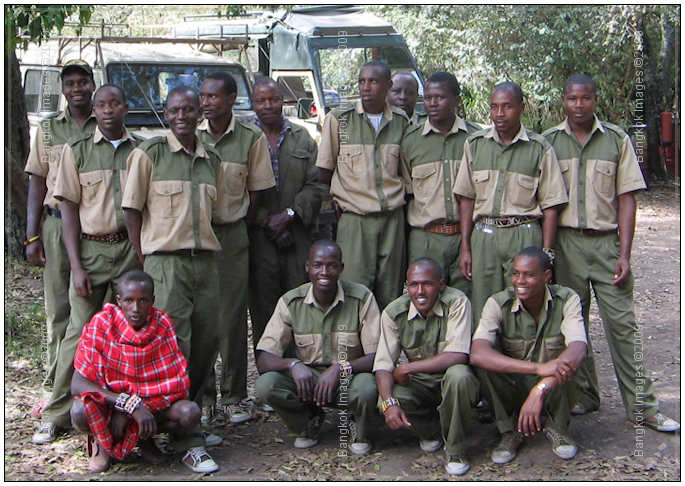
The staff around camp work hard, get paid very little, and do a great job, so I always give them a little something extra.
By all means bring pencils, pens, gum, and notebooks for the kids, especially when you go to the Masai villages. In addition to monetarily tipping the guides they sincerely appreciate any presents. I pack older T-shirts and tennis shoes, wear them on
the trip, and then leave them in the room in the tented camps. I try to leave most of my stuff in the tented camps because those employees have less access to tourists that tip.
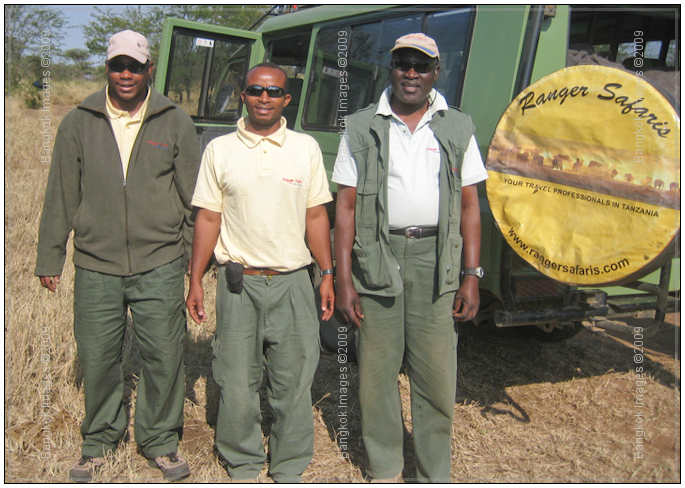
You don’t have to give a Swiss Army knife to your guide like I did for Zhou when we found the 3 black rhino in one day. A pair of Oakley sunglasses will do just fine
Communication
If you bring your mobile phone set up International calling before you go. Turn off wi-fi on your cell phone unless you really need it, and check on texting costs because you can get a real big and unpleasant surprise on your next bill. Make sure you
read the fine print on this one. So far I have used AT&T successfully once for a $5 per minute phone call home.
Almost every hotel has Internet access, even some of the mobile camps. Service ranges from OK to dismally slow and unusable. Some places charge, others do not. The better hotels you stay at, usually in the bigger cities on arrival, have the best free
Internet access. Do not do any confidential transactions over wi-fi- need I even mention that in a foreign country? Ask your travel agent for a list of which accommodations have Internet access. The information they give you is not always reliable
once you get there.
In general, compared to what we are used to, make the assumption that everything in Africa is unreliable.
Safari Companies
For the best photos possible put your money into a good safari company over good camera equipment. They know where the wildlife and native people are, the guides have eagle eyes, work together as a team, and know when they can get close to an animal.
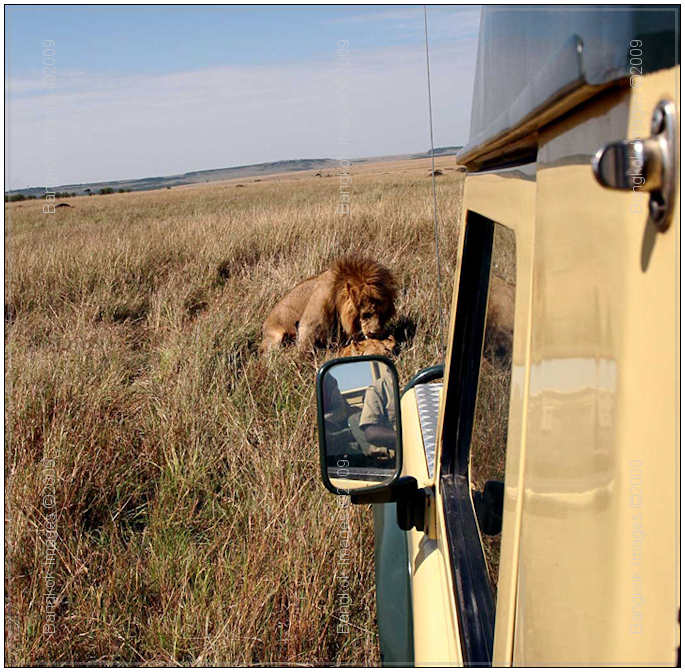
Is this close enough?
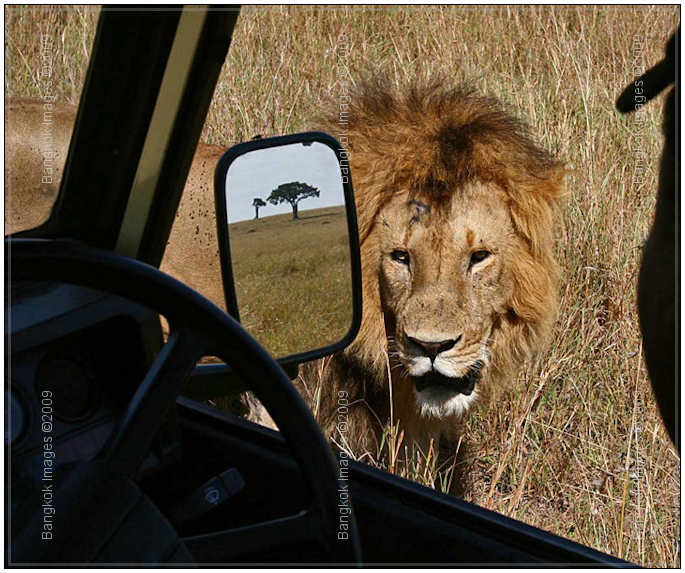
When he was finished the male came to the window and asked if he could bum a cigarette
Over the years I have used several reputable American companies for my safaris without a problem. A typical ten day safari of the kind I recommend costs $6,000 without international airfare. Everything else except tips is included. Once you experience
the logistics of a safari of this nature you will realize it is a reasonable price. You can get it cheaper, and you will get what you pay for regarding itinerary, accommodations, and number of people sharing your vehicle. You can also book an
Ambercrombie & Kent type of safari and pay double for the ultimate in luxury, although the wildlife viewing will be the same.
A reputable company will keep track of the migration and set up camp as close as possible. I like the larger companies, the ones that have offices in Africa, and are flexible with me on my itinerary. I learned something interesting on my last trip. Whether
you book with your local travel agent, National Geographic, a university alumni association, or some big travel agency or club, they almost all use the same local guide service.
On my recent Tanzania trip we used Ranger Safari’s, the largest in Tanzania and one I would recommend. This company guided our group from International Expeditions for the two 10 day trips I led. When they completed our trip they took our International
Expeditions sign down and put up a National Geographic sign in their back window for the next group they were taking. These routine safaris are run by basically all the same companies on the ground in Africa.
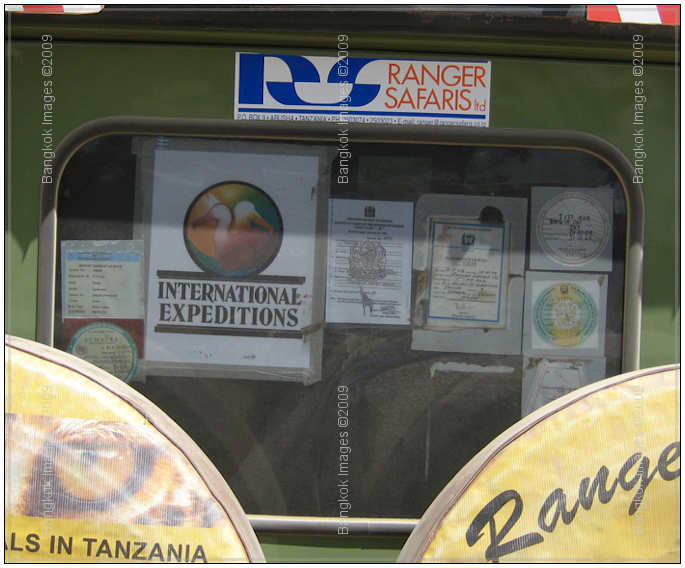
You need lots of permits to get into conservation areas and national parks. I counted 7 on our vehicle
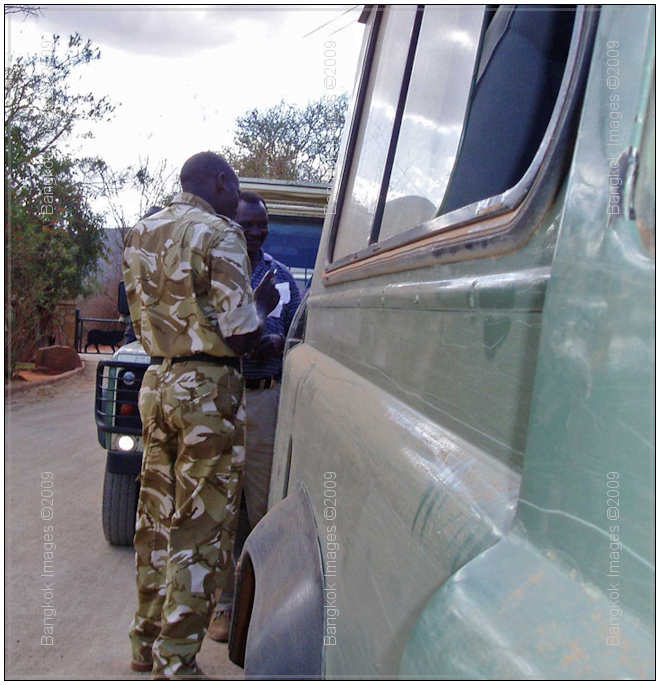
It is quite bureaucratic, and if your paperwork is not in order there will be a delay. We got delayed entering Tsavo National Park in 2005 for some unknown reason
Many safari companies put 5-7 people in a vehicle to make the trip more affordable. Set up your trip to have no more than 3-4 people per vehicle, even if it costs extra. Too many people makes it difficult to use cameras, people move too much for the vehicle
to hold steady when shooting, and everyone has a different agenda on what they want to see and how long they want to stay.
Don’t fall into the trap of being penny wise and pound foolish. You might be going on this trip once in your life so do not scrimp on this critical point. Find out from your safari company before you get a surprise on your first game drive. Budget
for a good safari and you will not regret spending a little extra. I would rather brag about what I saw on my safari than how little I paid.
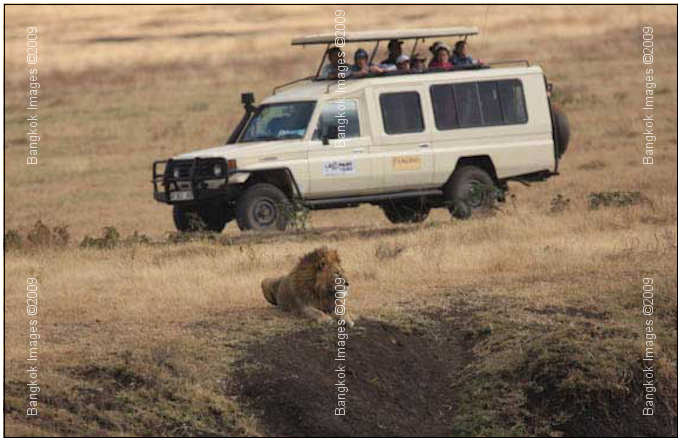
Sharing your vehicle with 7 people like this is not fun, and not worth saving money when you are this jammed in
Canon 1Ds Mark III, SS 1/2000th, Av, ISO 800, f/5.6, Canon 500 mm F/4 IS lens with 1.4X TC
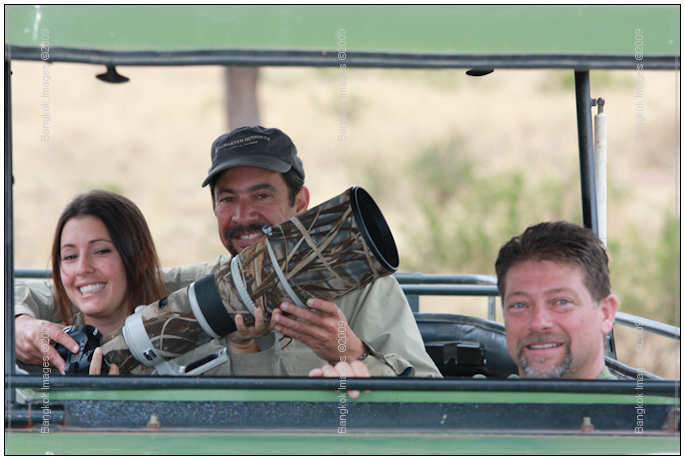
With just 3 people you have room to swing that 500 mm around, if only you can lift it
Canon Rebel XSi, SS 1/125th, Av, ISO 400, f/5.6, Canon 70-200 mm F/4 lens @ 165 mm
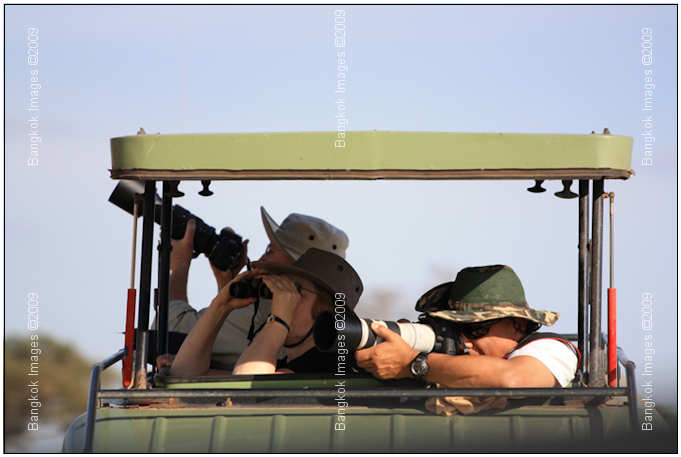
It’s not a bad idea to have one spotter with binoculars with two shooters when there are 3 per vehicle
Canon Powershot SD750, SS 1/500th, Av, ISO 80, f/4.9, Canon 5.8-17.4 mm lens @ 17.4 mm
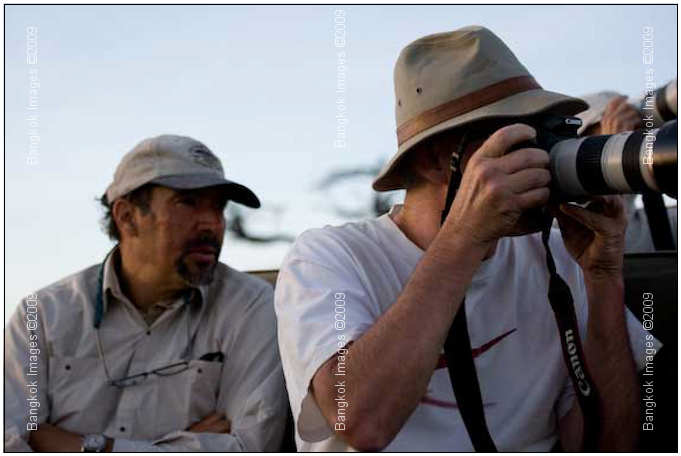
I usually hang back and help the photographer spot potential photos and assist with the use of my camera
Guides
Your safari guides are your friends, and are responsible for basically your whole trip. They will meet you at the airport on arrival and get you to the first night’s hotel. They will be there first thing in the morning to for game drives. They
will take care of bathroom breaks, water and food in the vehicle, park entrance fees, and safety. They are gentlemen and make or break the trip. I have never had anything but a great experience with dozens of them.
When you book with a bona fide company you will find them reliable and professional. Once that rapport gets going the guides will go all out to entertain you, keeping that tip at the end of the trip always in their thoughts.
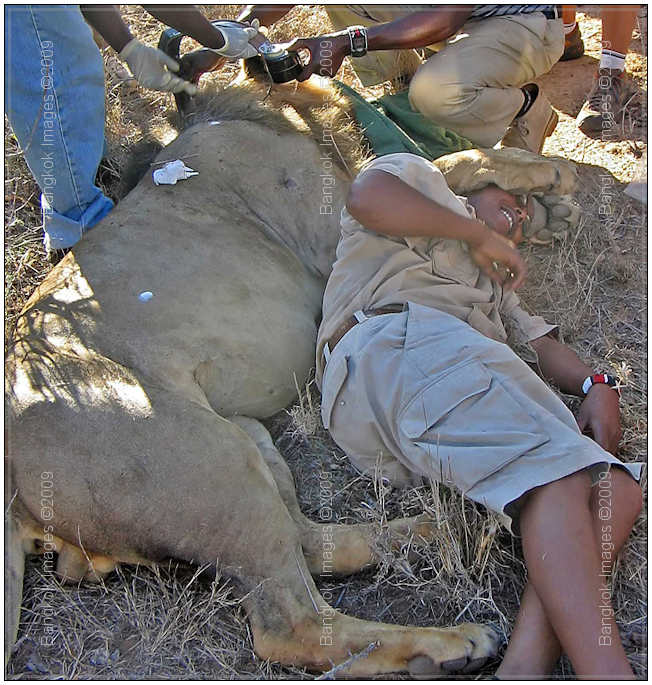
Our guide Simon showing off his masculine physique compared to the king of the beast
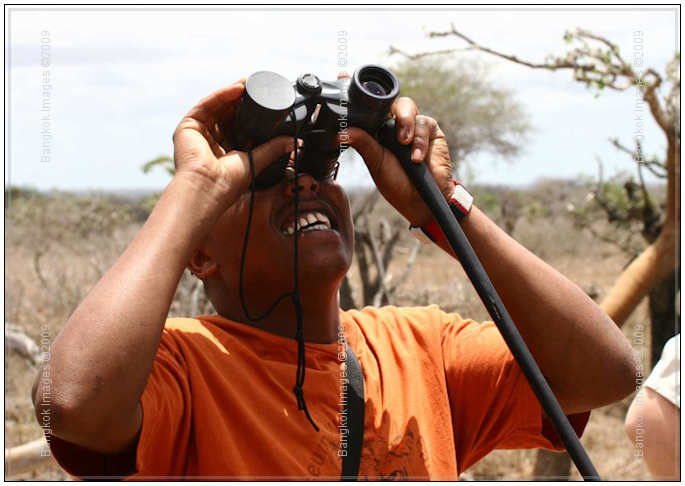
Simon showing us the latest technique in one-eyed binocular viewing
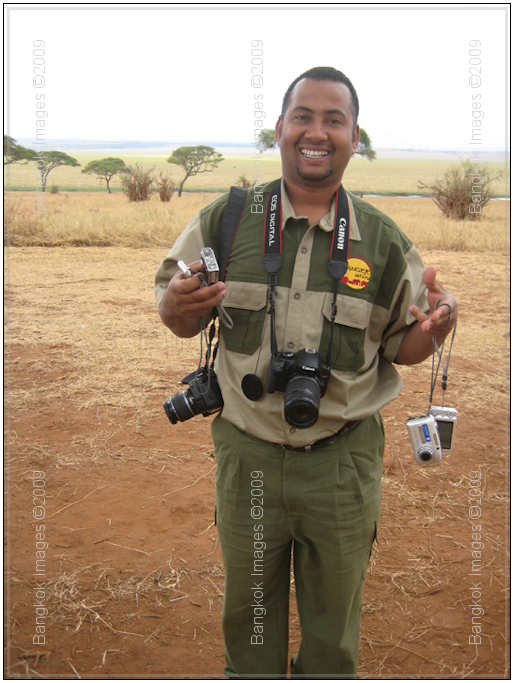
We asked Firoz to take a group photo of us. Little did he know what he was getting in to when we all handed him cameras.
Canon Powershot SD750, SS 1/500th, Av, ISO 80, f/2.8, Canon 5.8-17.4 mm lens @ 5.8 mm

This is the photo he got so he did fine by me
Canon Powershot SD750, SS 1/125th, Av, ISO 80, f/8, Canon 5.8-17.4 mm lens @ 5.8 mm
I spend extra time with the guides before my guests arrive (I go a day early to make sure everything is in order) and during the trip. This motivates them to keep their eyes peeled when we are on a game
drive.
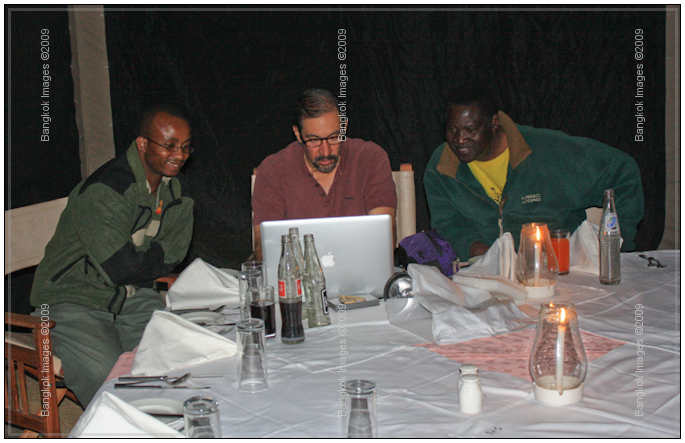
Reviewing photos taken during that day and instructing how they can help the photographers for the next days shoot regarding sun, position, angle, etc.
Canon 50D, SS 1/60th, Av, EV +1, ISO 1600, f/4.5, Canon 17-85 mm lens @ 28 mm
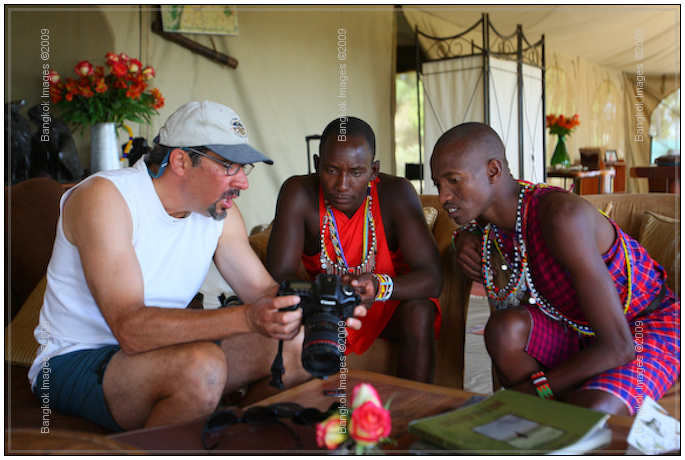
They are eager to learn about photography even if they will never own the equipment you bring
Schmooze the guides, teaching them anything American, because they are hungry to learn. This includes politics and slang. On my last trip to Kenya the guides tried to impress me with their knowledge of America by repeating “George Bush” and “Bill Gates”. The guides heard of them, but they had no idea who they were.
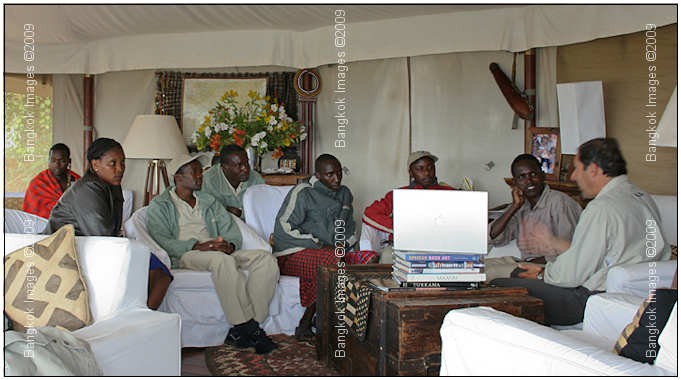
They were a rapt audience one afternoon as my guests were taking a siesta and I talked about their beloved “George Bush and Bill Gates”, our political system, and especially the criminal justice system and our rights. Their system is vastly
different than ours.
We forget how much slang is in our vernacular. If they ask you how the food is and you say “it hits the spot” they might need an explanation. When it is time to move on they love the saying “hit the road jack”. They love learning our slang because they can use it on future American clients with the ultimate goal of getting that bigger tip again. Americans make up 70% of their clients, and they respect us immensely, so utilize this to your best advantage.
Be prepared for their British version of English. At first you will have a hard time with some words. For example, we pronounce the word predator as pre-da-tor. They pronounce it as Pree-dater, with emphasis on the Pree.
They are always polite and would not even think of laughing at you or insulting your lack of knowledge. Although they will not let on, they must shake their heads sometimes at some of the things the guests say. Here are two common faux pas:
The large, tan colored, big cat you will see often during the trip is not a tiger, it is a lion. Do I even need to show you a picture of the two?
The large cow-like animal with the big horns is a Cape buffalo (or African buffalo) not a water buffalo. Water buffalo’s are in India.
.
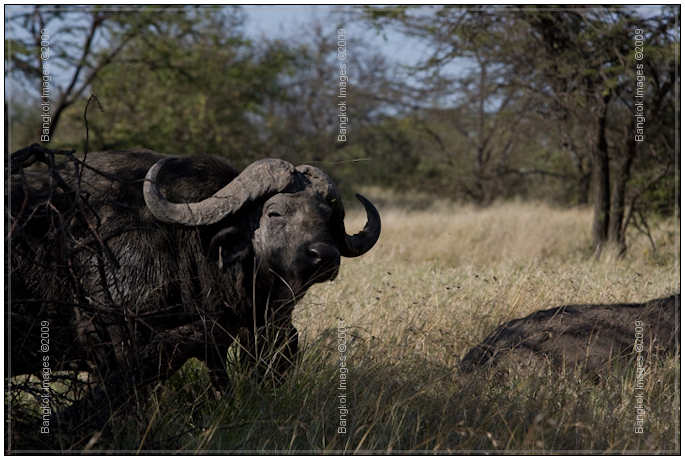
This is a Cape Buffalo-got it? When you find 1-2 older males on their own the guides will give them a wide berth. These buffalo do not have the protection of the herd, can be aggressive, and will charge first and ask questions later. Hunters used to call
them “black death” They are formidable animals, although hippopotamus kill more people in Africa.
Learn the difference between a leopard and a cheetah:
Cheetahs do not look like leopards. Study pictures of them, they are all over my photography page.
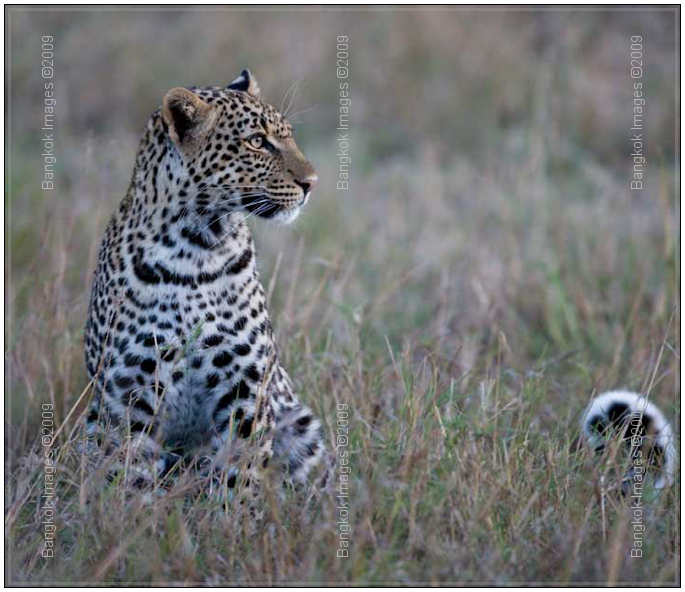
Leopards are stockier than cheetahs
Canon 1D Mark III, SS 1/2000th, Av, ISO 640, f/5.6, Canon 70-200 mm f/4 IS lens
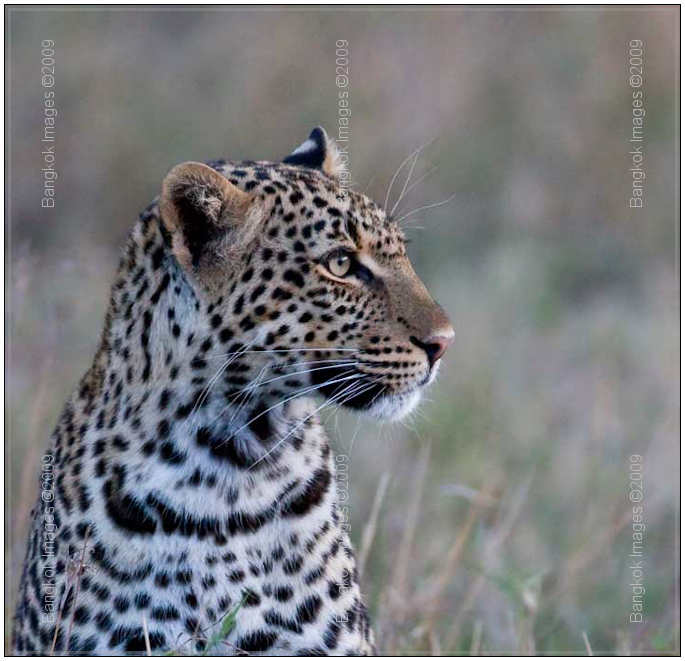
They have a broader face and a dark collar under their necks
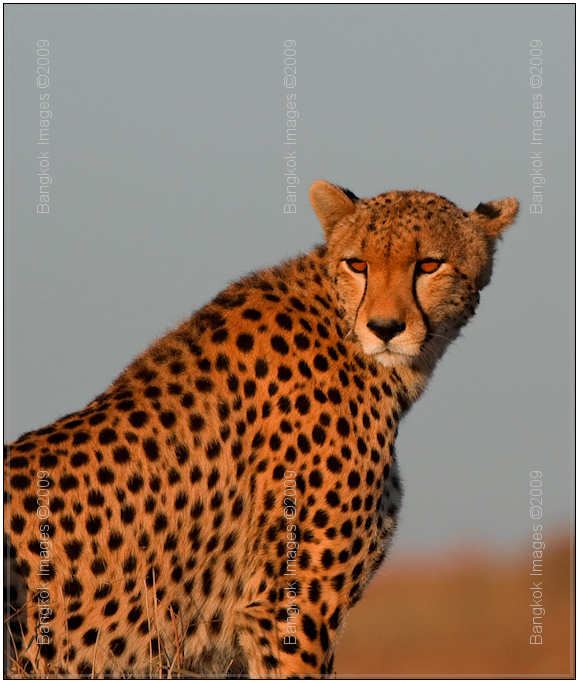
Cheetahs are much leaner than leopards
Canon 5D, SS 1/320th, Av, ISO 200, f/9, Canon 500 mm f/4 IS lens
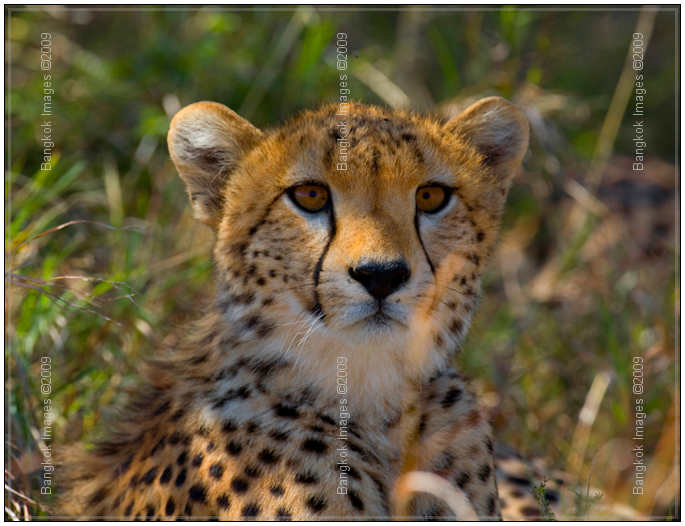
And have a different face with dark tear drops
Canon 5D, SS 1/320th, Av, ISO 200, f/8, Canon 500 mm f/4 IS lens
Knowing the more unusual (to us North Americans) wildlife ahead of time by studying them and asking above average questions will show you are prepared and interested. This motivates the guides to teach you
and find wildlife. Here are two examples of how to impress the guides:
Learn how to tell an Impala from a Grant’s gazelle because most guests mix them up. I will give you one clue:
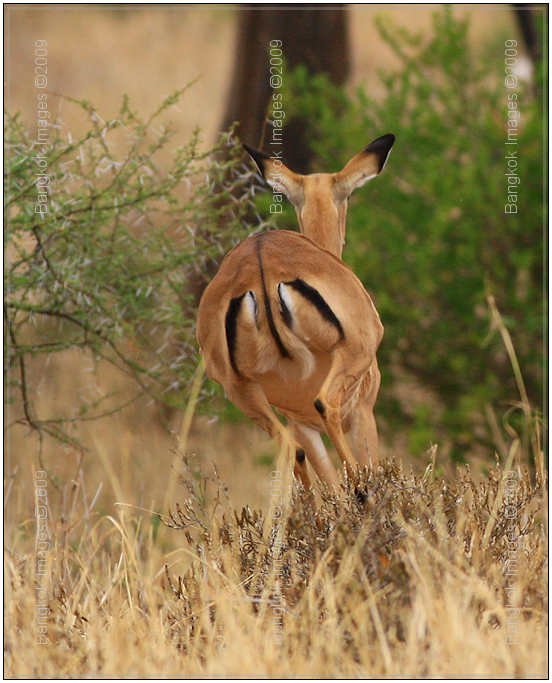
This is the rear end of an impala
Canon 1D Mark III, SS 1/1000th, Av, ISO 640, f/5.6, Canon 400 mm f/5.6 lens
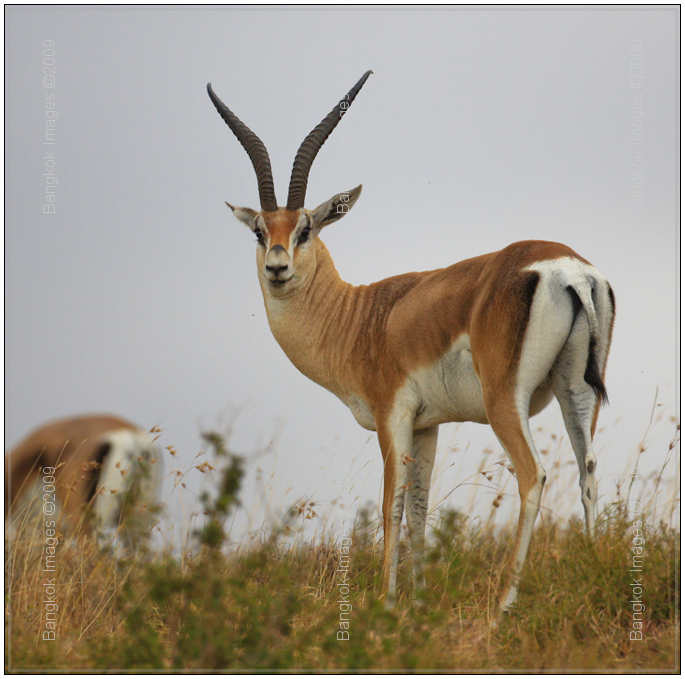
The rear end of a Grant’s gazelle
Canon 1Ds Mark III, EV + 1 2/3, SS 1/1600th, Av, ISO 800, f/4, Canon 500 mm f/4 IS lens
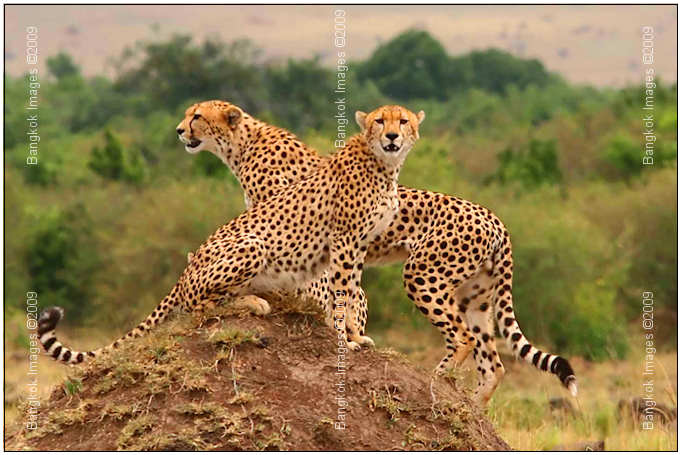
A solitary cheetah is most likely a female. The males, which can be brothers, usually stick together
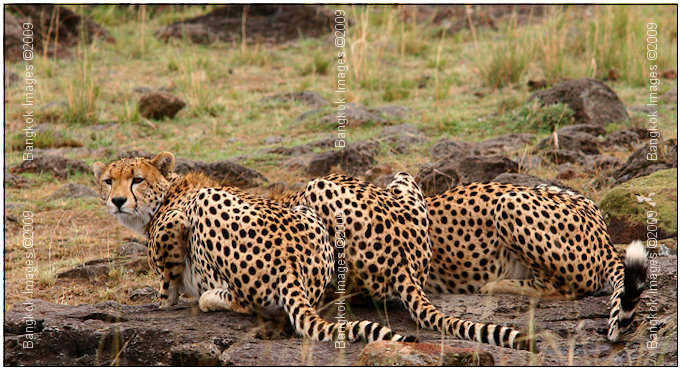
Actually, there are 3 brothers in this coalition
Since we are on to naming groups of animals, another way to impress the guides is with some scientific naming of these groups. I will give you just a few (you already know a group of cheetah’s is a coalition) to memorize and show your knowledge:
- A group of leopards is a leap
- A group of giraffes is a journey
- A group of rhinos is a crush
- A group of mongoose is a mob
- A group of zebras is a dazzle
- A group of warthogs is a sounder
- A group of owls is a parliament.
- .
And my favorite one: A group of guides is called “trouble.”
While we are at it naming lists I assume you already know the “Big Five” African animals. For a little challenge see if you know what the “Little Five” are. I will give you a clue: they all relate back to the Big Five. Try to figure them out before you Google them.
Personally I have never made a fool out of myself in front of the guides. OK, almost never. We were watching a pride in the Mara, the guide in the front seat, my friend in the middle opening, and me at the back opening looking backwards at a large male
resting with two females. It looked like a good shot so I extended myself towards the back and brought the camera up to shoot. I accidentally hit the bill of my cap and it went flying towards the male lion and landed right in front of him. The
lion jumped and roared, our guide jumped and asked me what happened. I told him the wind blew my cap off, not daring to tell him that I knocked it off.
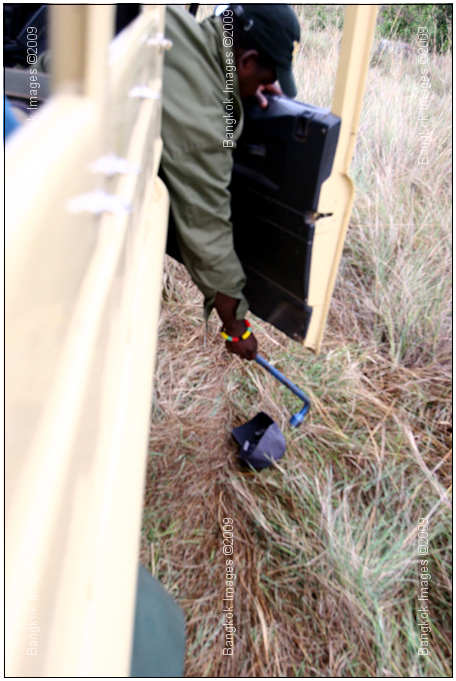
Here he is retrieving my cap with a tire iron while the lion stood 20 yards away. I kept cursing the wind hoping he would believe me
If you want to have some fun with them ask one guide in private how many wildebeest make the migration. Then ask another guide the same question in private. When you see them together bring up their potentially different numbers and let them go at it.
They will love the fact you are teasing them and become more endeared to you.
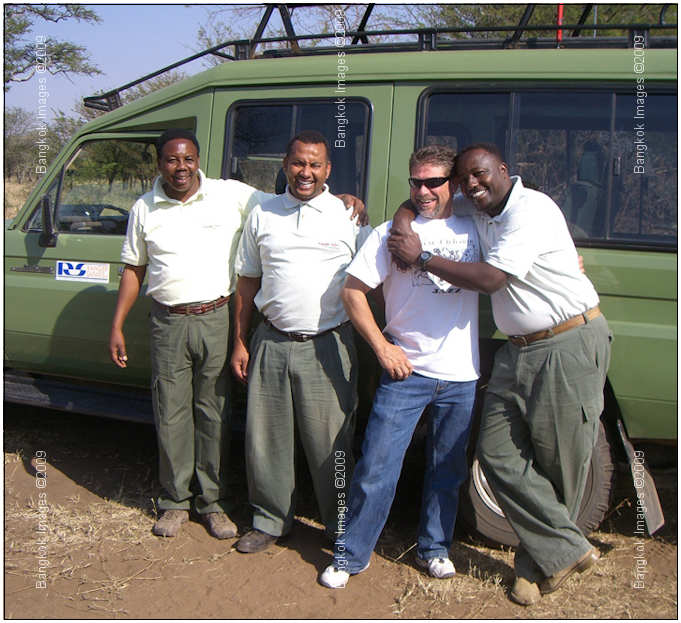
If you get to this stage you are guaranteed to have a great trip
Canon Powershot SD750, SS 1/250th, Av, ISO 80, f/8, 5.8-17.4 mm lens @ 5.8
By the way, they are experts at fixing one of those flat tires you will probably experience.
Weather and Clothing
You will be surprised how cool the mornings and evenings are. Bring a jacket or fleece, and even a light windbreaker. The Ngorongoro crater hotels are at 7,000 feet and quite cool. Once midday arrives it will be hot, usually in the 90’s F, with
an intense sun beating on you, so make sure you layer and can shed down to something light. The sun is intense at the equator so a hat and sunglasses are a must.

If you are in an area where you can go out at night it can be quite cool, especially if they use open vehicles
Khaki, light brown, tan, cream, and green tend to be the colors de rigueur. You can wear any colors you want but you might look out of place compared to the guides and everyone else. If you want shots of geeky looking American and English tourists, all
decked out like big game hunters, with cameras dangling from their necks, then this is your big chance.
The Tanzania government frowns upon wearing camouflage clothes. You do not need camouflage so don’t push the issue with them and cause the guides any problems. Bring long and short sleeve shirts and pants. Tennis shoes and sandals are the best
footwear because you will be in vehicles and walking little unless you are on a specific walking safari. Travel light regarding clothes due to airline baggage fees and the fact the camps will wash your clothes.
Vehicles
Safari vehicles are usually Land Rovers or Land Cruisers. Some guides have a preference, others don’t care. Each safari company modifies them for their individual needs. Getting in and out with heavy camera equipment in hand or on your back can
be difficult, and you can easily slip or strain yourself
The vehicles are very bouncy so make sure you and your camera equipment are stable before moving. It is easy to fall when shooting with a big lens and the vehicle is moving over the rough dirt roads. When you lay your camera on the seat while standing
put the beanbag gently on top of it so it does not bounce off the seat when the vehicle is moving.
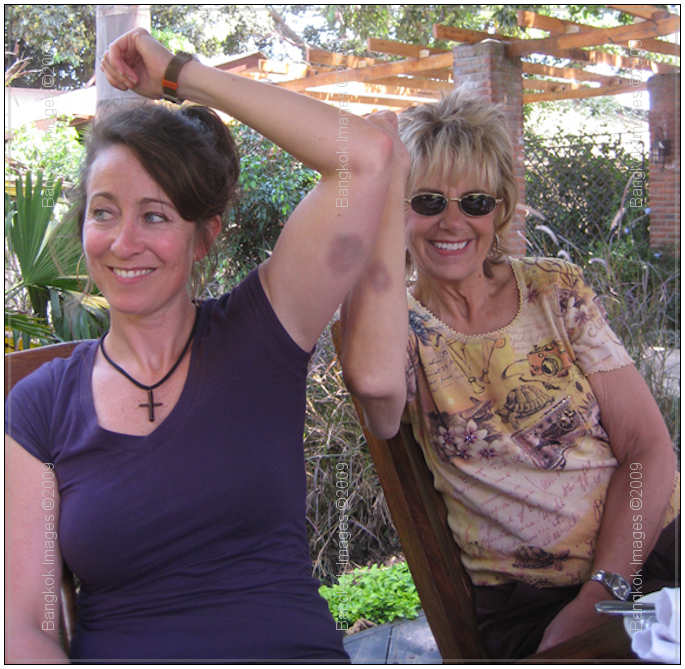
Hang on when the vehicle is moving because you can easily get knocked to the ground when holding on to heavy cameras and lenses
On my last trip in Tanzania with Ranger Safari’s their modified Land Cruisers had awesome roofs that lifted up for 360 degree viewing, yet they protected us from the mid day sun. You might want to check with your safari company about the vehicles
they use, especially in that intense sun near the equator.
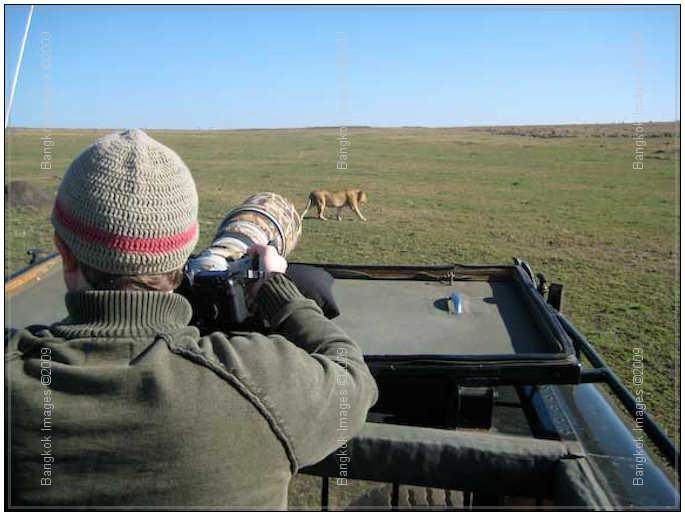
A little too much exposure for me, especially if you are out all day. Notice what John is wearing in the cool morning air
Their roof modification provided shade from the intense mid day sun straight up, and still offered freedom of movement for my guests. The shade not only protects you it seems to make photography a little easier, especially when you want to look at your
pictures on the back of the camera.
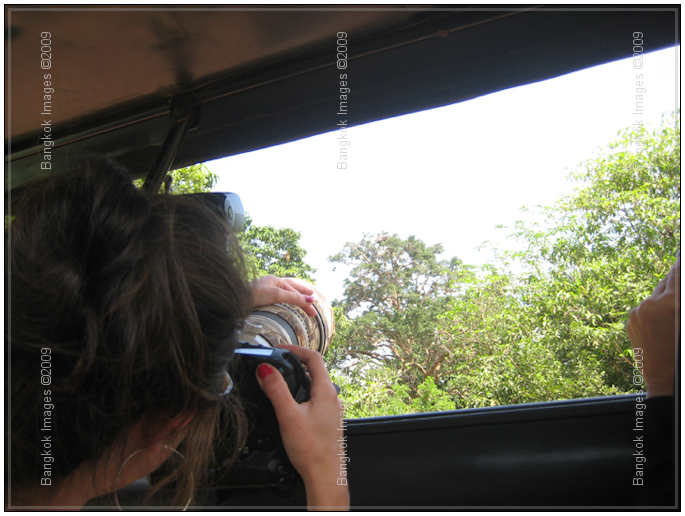
You cannot see what Silvia is shooting at because it is quite far away. The shade makes it easier for her to shoot and be comfortable.
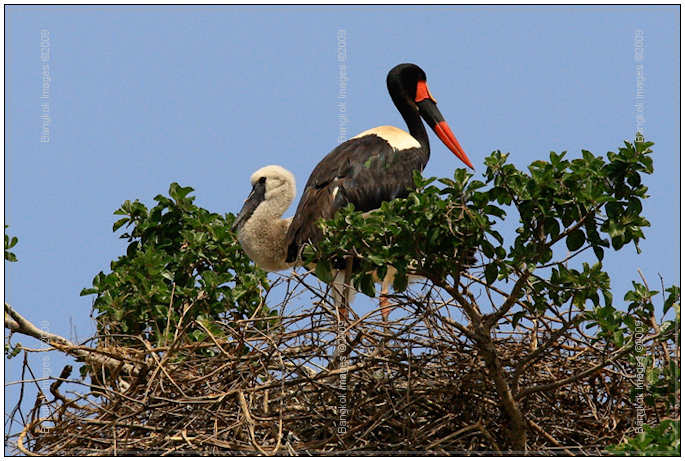
She nailed a saddlebill stork and its chick
Canon 1D Mark III, SS 1/300th, Av, ISO 800, f/8, Canon 500 mm f/4 lens with 1.4X TC
There is no room for a tripod when several people are in the vehicle. This is OK because there is no need for a tripod with the beanbags. I have used lightweight Gitzo carbon fiber tripods on many trips and do not feel they are worth the added weight
for my style of photography, so I do not bring them any more. I never bring beanbags from home because all of the reputable companies have them. Confirm with your travel agent to make sure. Practice with beanbags before your trip before you decide
on bringing that tripod. If you are a monopod fan this might be a good alternative to a tripod.

My Wimberley and Sidekick combination with my 500 mm in Kenya 2007. This is around the time I stopped bringing them for use in the vehicle
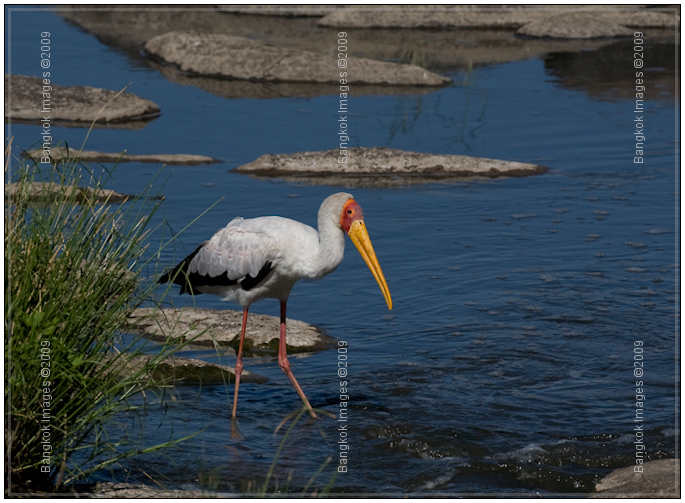
OK, I admit tripods can be quite useful, especially at our lunchtime when a Yellow Billed stork is looking for its lunch of frogs. Love that Canon 500 mm f/4 IS
Canon 5D, SS 1/1000th, f/8, Av, ISO 100, Canon 500 mm f/4 IS lens
If dust bothers you bring a kerchief. On some trips I have not encountered much dust, but be prepared just in case. If you go during the busy summer season numerous other vehicles will kick up significant dust. This might be a factor in your decisions
regarding when to go.

Most of the dust will be kicked up from the vehicles. Some guides don’t seem to notice this. Its OK to tell them to keep enough distance for the dust to settle
Accommodations
There are many nice to very nice tourist hotels at the arrival cities and in the National Parks. These hotels give you an opportunity to meet other travelers from the U. S. and around the world.
The food ranges from OK to good, and the service is good. It used to be dismally slow in the 1980‘s but has improved substantially since then. There are some differences in customs so be patient as the hotel and wait staff learn.

Make sure you try their Tusker beer. I have an extra one in my fridge if you want to come over and give it a taste
My favorite accommodations are the tented camps. Some are mobile and taken down periodically, others are permanent. These are the only way to go in my opinion. Most are small, quaint, have excellent food and service, and are in the middle of the action.
Almost every night you will hear lions and hyenas and other sounds that are unidentifiable.
In the tented camps you will have a comfortable bed, they will wash your clothes, and you have flush toilets and hot water for a shower. Its luxury camping, and you will get that “Out of Africa” experience. I have never had a guest that didn’t rave about them.
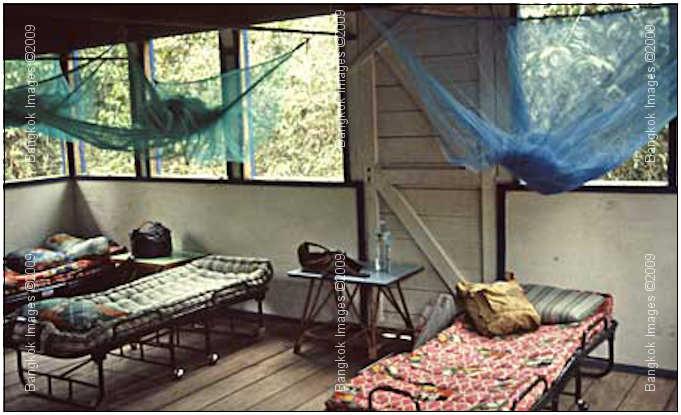
See how luxurious the accommodations are!
Oops, wrong photo, those are the beds at Camp Leakey in Borneo
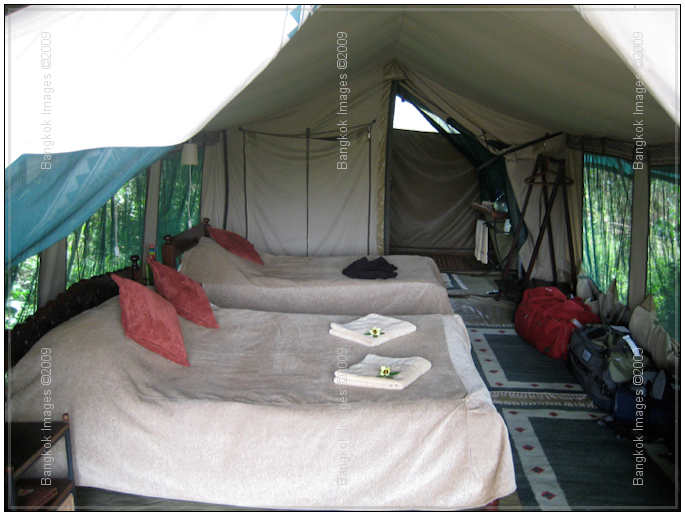
That’s a little better
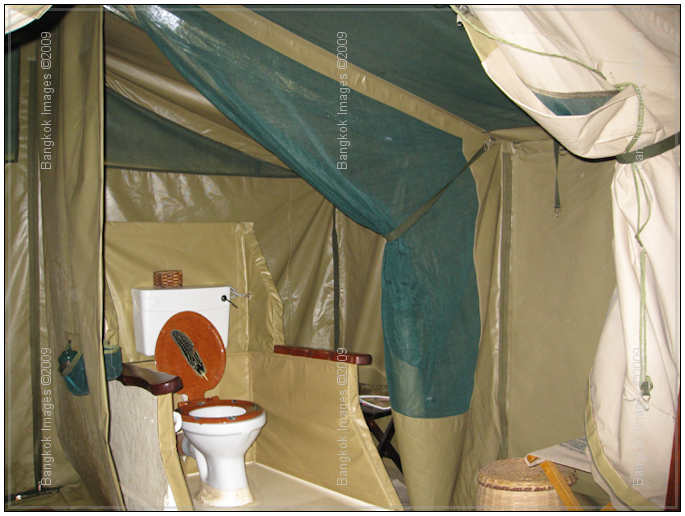
Yes, there are flush toilets and hot showers in the tents
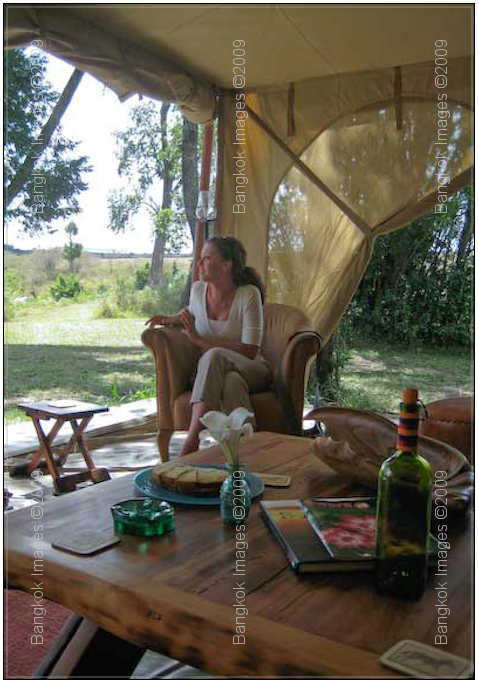
In Kenya they keep the British tea time tradition going at 4 PM every day
Photography Training for Your Safari
Sports photography and wildlife photography are similar. For professional level sports training I went to Peter Read Miller’s sports shooting workshop in Denver. Peter has been a Sports Illustrated photographer for over 30 years. Not only is he
my mentor he is a personal friend and client.
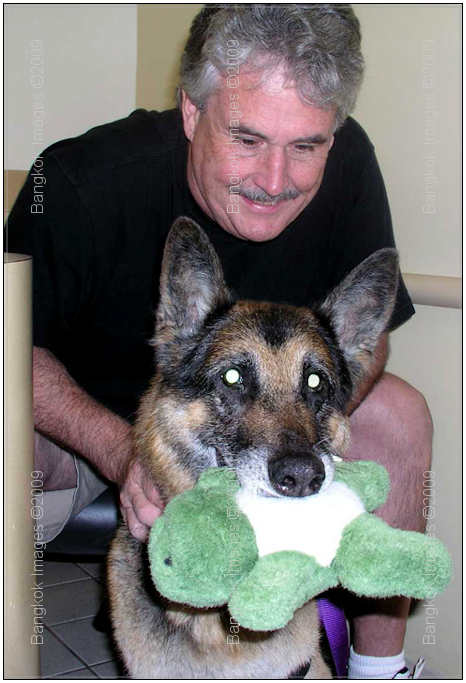
Peter is a passionate animal lover. Here he is at my clinic with his beloved Shiloh
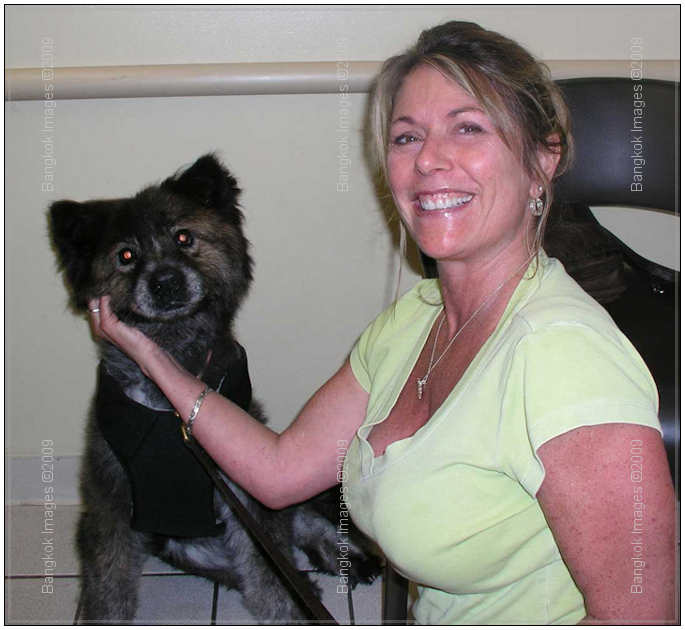
This is his girlfriend Kallie with another of his beloved pets, Queenie
Peter holds his workshop every year in April, and I highly recommend it for your sports photography, wildlife photography, and to play with the latest equipment from Canon. Being around a group of avid amateur and professional photographers will increase
your enthusiasm for this great hobby and profession. Here is the link to his yearly sports seminar called “Intense Moments: Photographing Sports."
Peter invited me to help the Sports Illustrated team shoot a Rose Bowl game and a BCS game in Pasadena. My job was to assist him and courier the compact flash cards to the editors in their booth at the stadium.
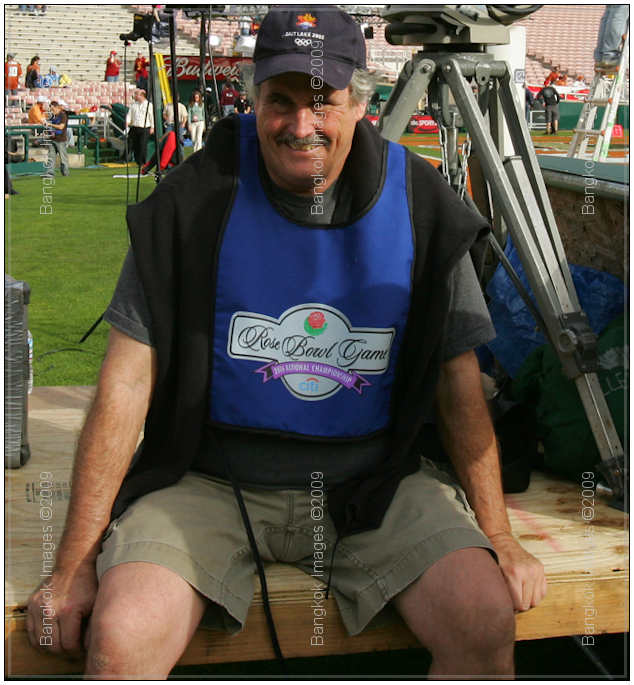
You get there 3-4 hours before the game, so there is lots of down time to talk photography with the S I team

Getting access to the playing field is a real thrill, and gives you a great vantage point for your photography. What’s even cooler is the press pass you get that gives you access to the cheerleaders’ locker room!
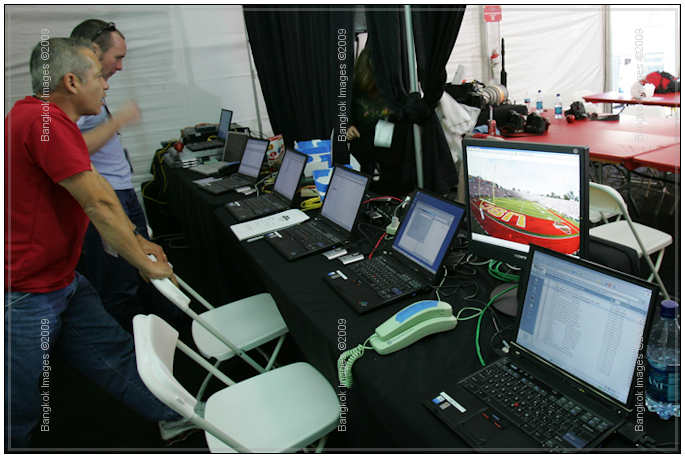
Watching the editors preview 2 pictures every second was fascinating. They knew their shit. There were 6 photographers and 7 editors, so things moved fast
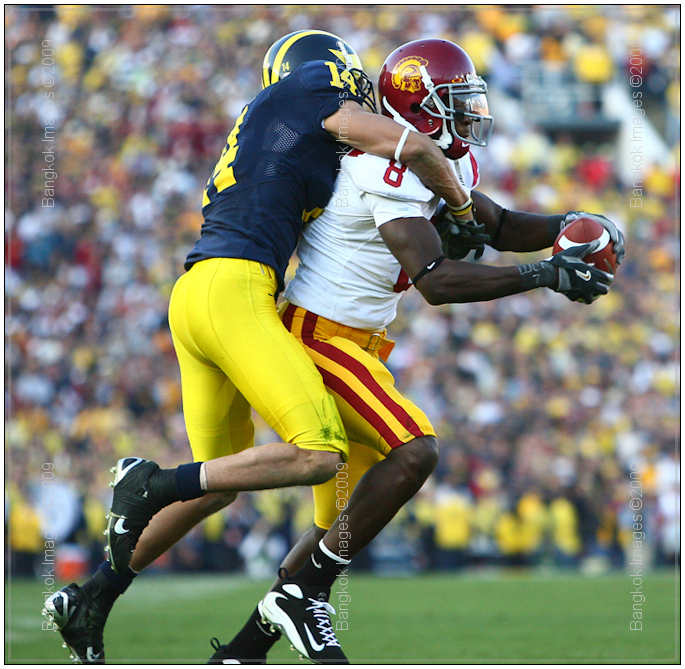
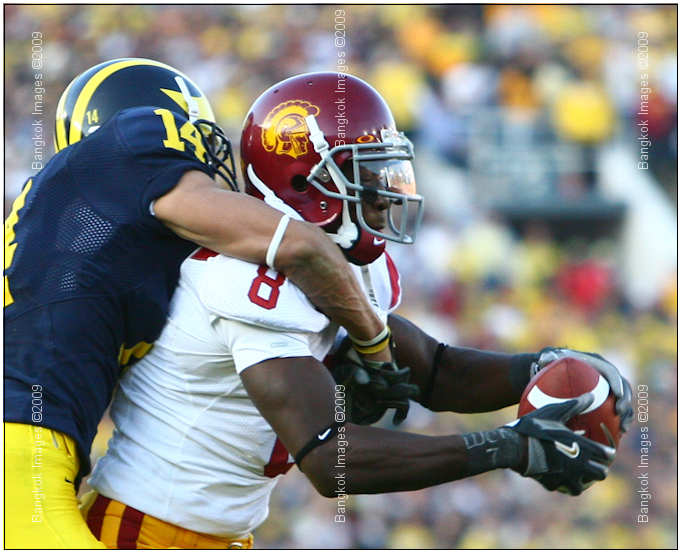
Even though my pictures do not go in the magazine, I was able to sneak away and grab a few (actually more than a few) with the good lighting at the Rose Bowl game the year after the BCS game
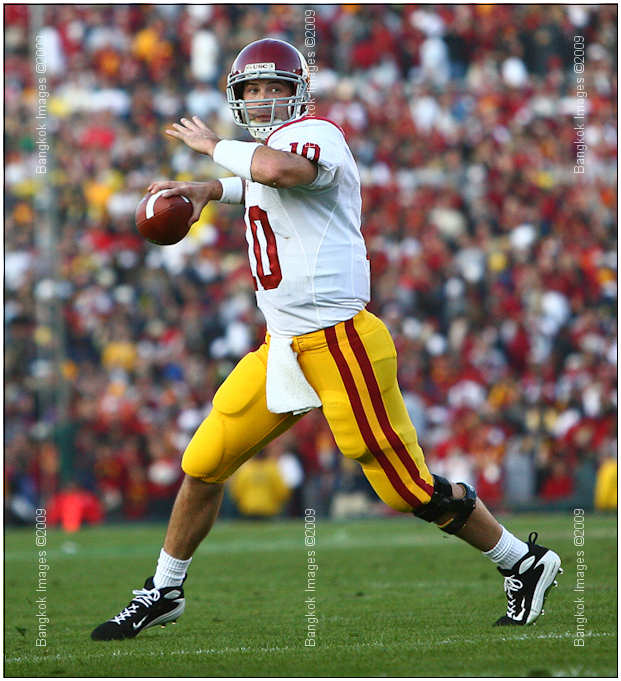
Canon Mark II-N, SS 1/1300th, Av, ISO 800, f/3.5, 70-200 mm f/2.8 IS lens at 200 mm
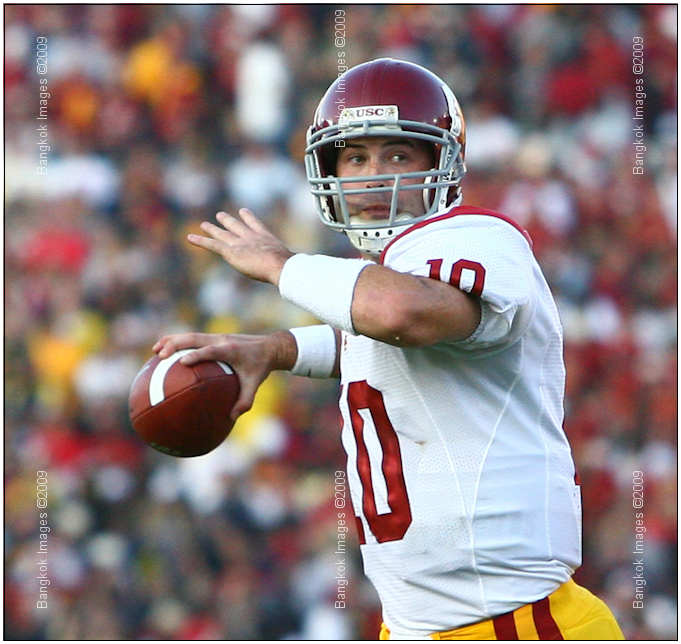
Canon Mark II-N, SS 1/1600th, Av, ISO 800, f/3.5, 70-200 mm f/2.8 IS lens at 200 mm
The bottom line- if you want to have a ball, learn lots of sports photography, increase your photography skills significantly, and meet photographers with similar interests that will help you, go to his workshop.
Peter likes the challenge of wildlife photography. In football, even though the action is somewhat unpredictable, he knows when it is going to start and can predict where the action might end up. As such, he can anticipate and be ready. This is different
than wildlife photography as we all know.
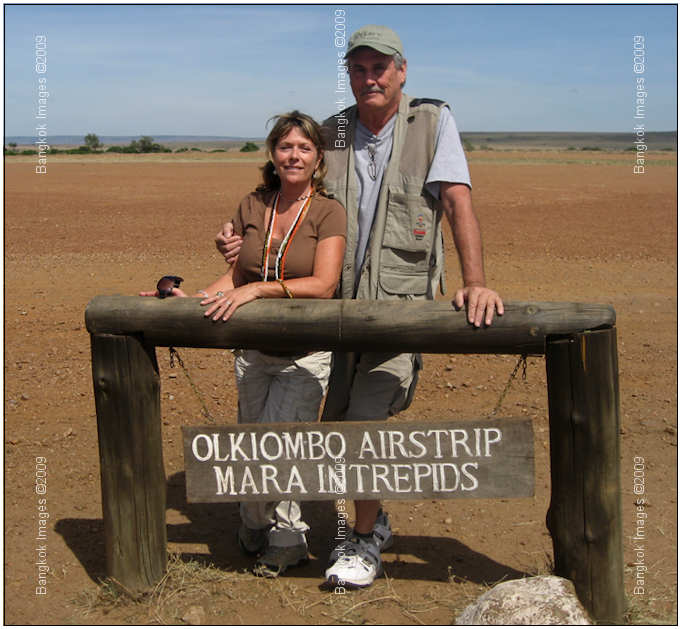
Peter and Kallie joined my 3rd group in Kenya in 2007
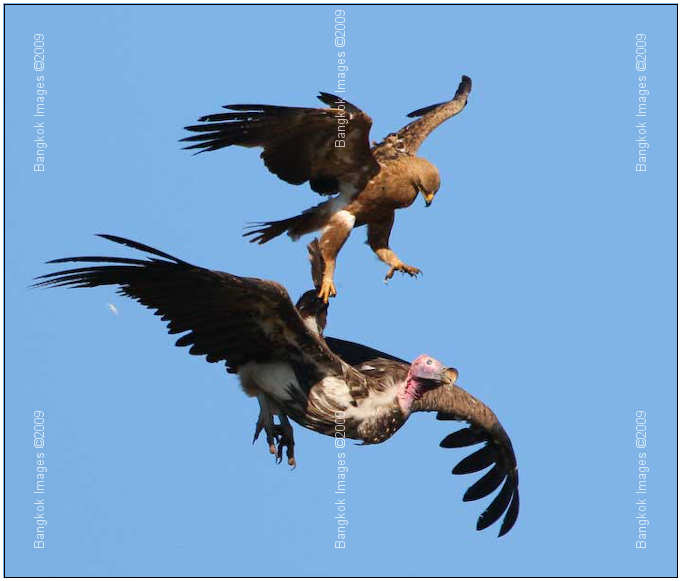
I taught Peter everything he knows about photography, and had to set the camera and focus for him when he captured this Tawny eagle attacking this Lappett-faced vulture in mid air
Canon 1D Mark III, SS 1/3200th, Av, f/6.3, ISO 640, Canon 400 mm f/2.8 lens, 2X TC
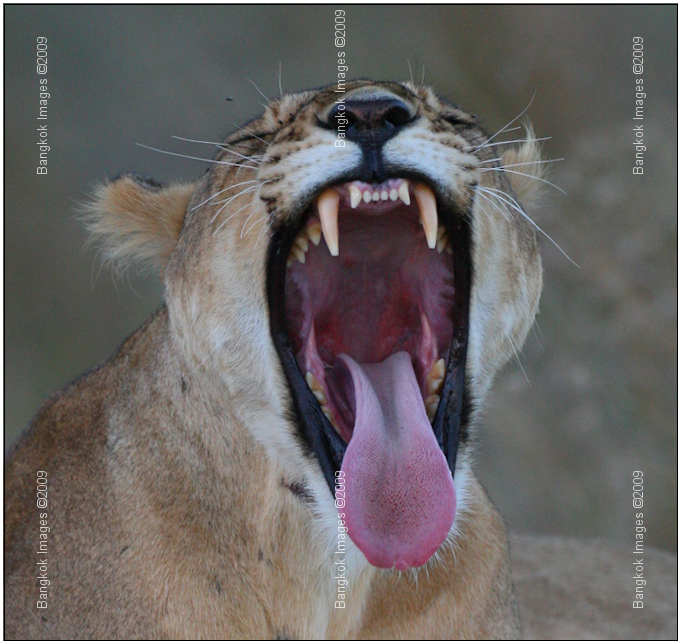
He learned fast and got a few other keepers
Canon 1D Mark III, SS 1/640th, Av, f/4, ISO 1250, Canon 500 mm f/4 IS lens, flash
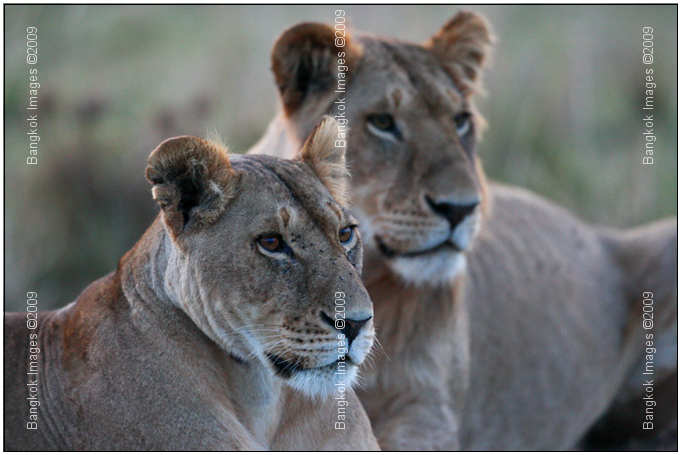
Canon 1D Mark III, SS 1/25th, Av, f/2.8, ISO 2500, Canon 400 mm f/2.8 lens
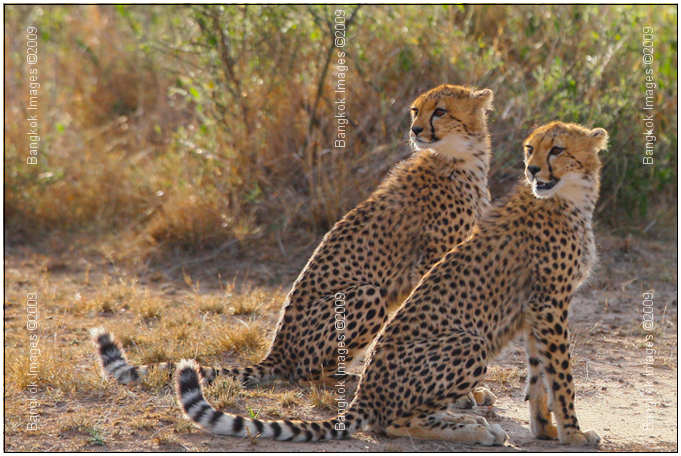
Canon 1D Mark III, SS 1/2000th, Av, f/4, ISO 640, Canon 400 mm f/2.8 lens
Peter and I are talking about both of us leading a group of his fellow sports photographers on a safari some time in the future. Let us know if you are interested in joining us.
In addition to formal training like Peter’s workshop I read (and reread when I forget things) lots of photography books. I go on numerous photography web sites daily to learn, read about other peoples’
experiences, and look at their photos. This is how I keep my self in continual learning mode.
The rest of my personal training comes from shooting photos all the time. This keeps my skills up and makes the use of my camera second nature. I also know which lenses work best for me. A waterway 10 minutes away from my home is one of my favorite places
to practice.
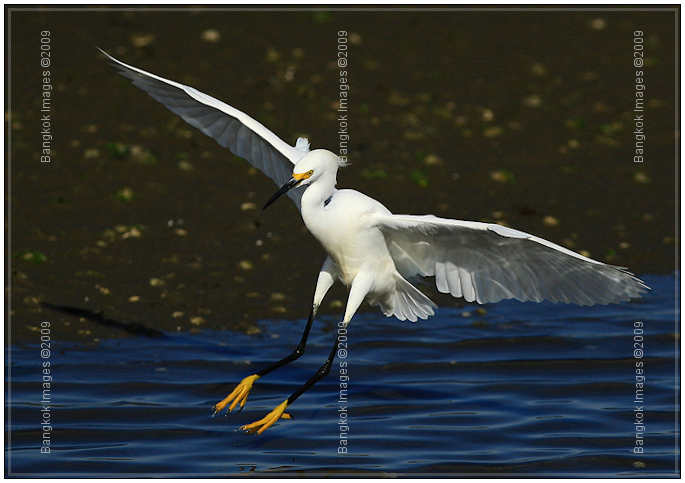
I shoot lots of flying birds to keep my focus skills up and not blame my camera
Canon 1D Mark III, SS 1/8000th, Av, f/3.5, ISO 200, Canon 300 mm f/2.8 IS lens
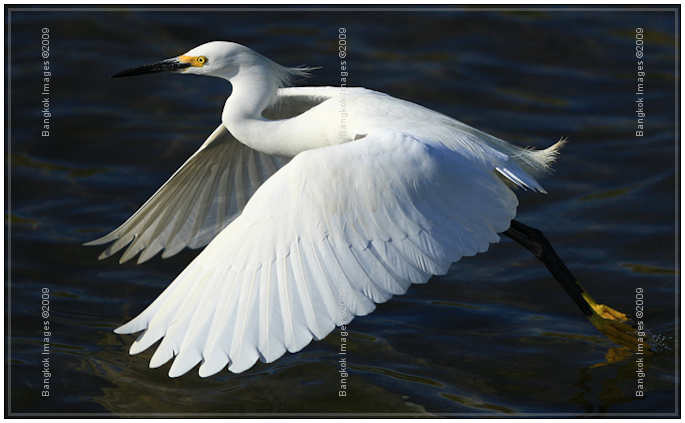
Canon 1D Mark III, SS 1/8000th, Av, f/2.8, ISO 200, Canon 300 mm f/2.8 IS lens
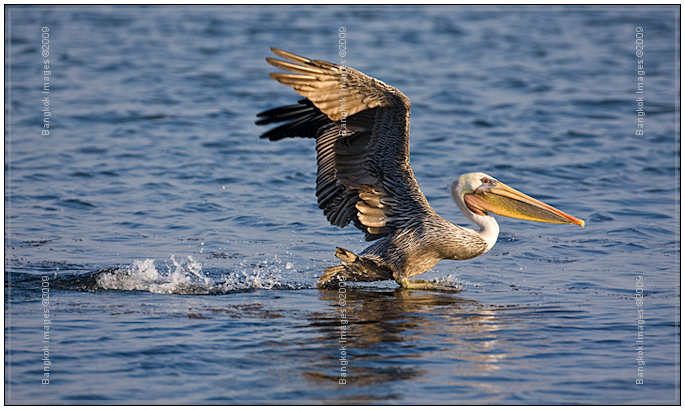
We get injured pelicans at work almost every day. They are often entangled with fishing line. Its nice to see a healthy one out in nature
Canon 1D Mark III, SS 1/1600th, Av, f/5.6, ISO 400, Canon 500 mm f/4 IS lens
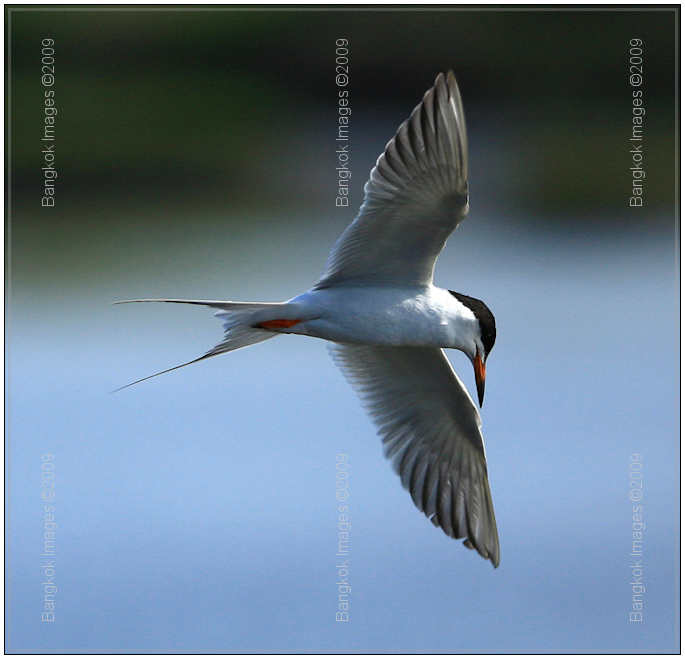
If you can consistently (I am about 1 out of 15 at best) nail a lightning fast Forester’s tern in mid flight you are good
Canon 1D Mark III, SS 1/5800th, Av, f/2.8, ISO 200, Canon 300 mm f/2.8 IS lens

Even if you do not have a waterway near you odds are good wildlife abounds in your neighborhood for practice
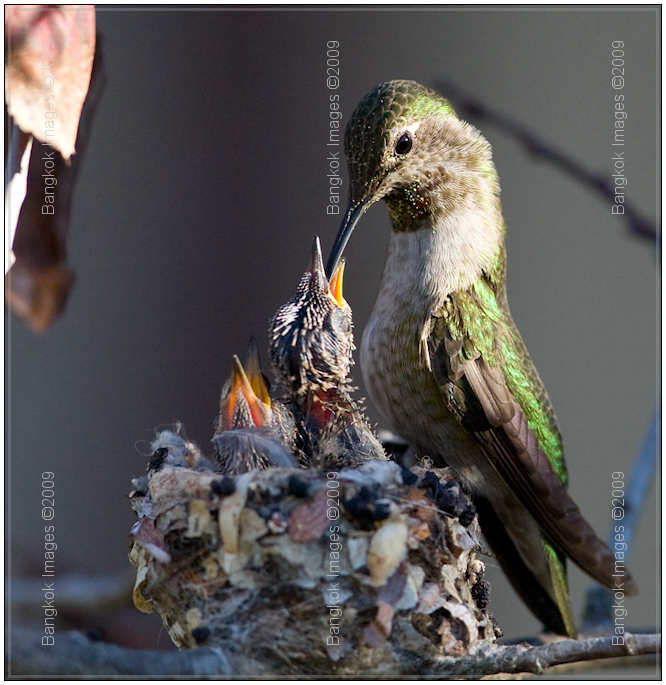
Canon 1D Mark III, SS 1/1250th, Av, f/4, ISO 800, Canon 300 mm f/2.8 IS len
I own a place in northern Michigan that is filled with North American wildlife. I go there often because it is so beautiful, especially in the summer and fall. Some day I will write an article about shooting the wildlife found in this area.
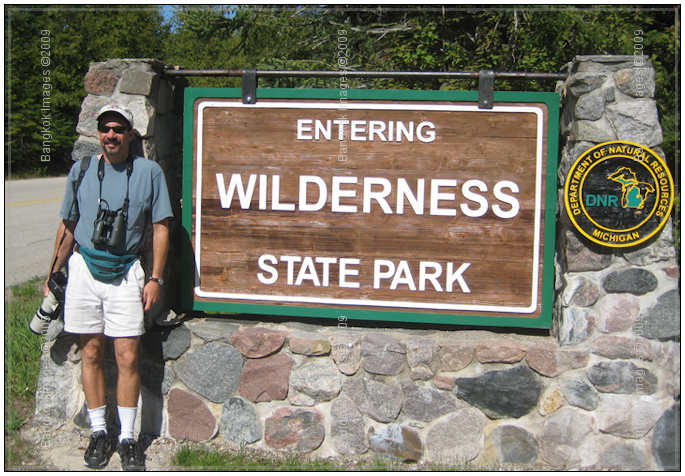
Northern Michigan is a wildlife mecca
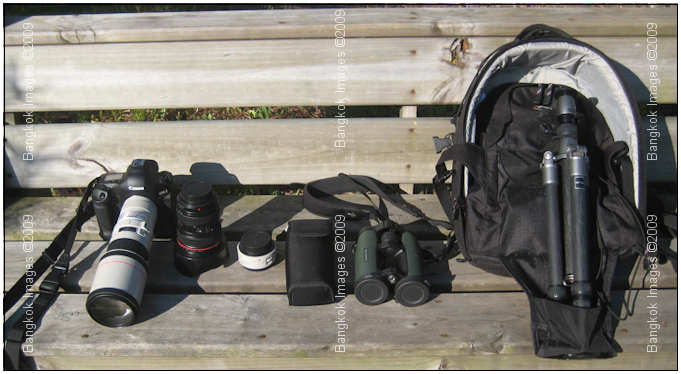
My hiking pack consists of a Canon 1 Ds Mark III, 400 mm f5/6 lens, 24-105 mm lens, 1.4X TC, 580 EX flash, Swarovski 10X binoculars, Gitzo lightweight carbon fiber tripod, Loewpro backback
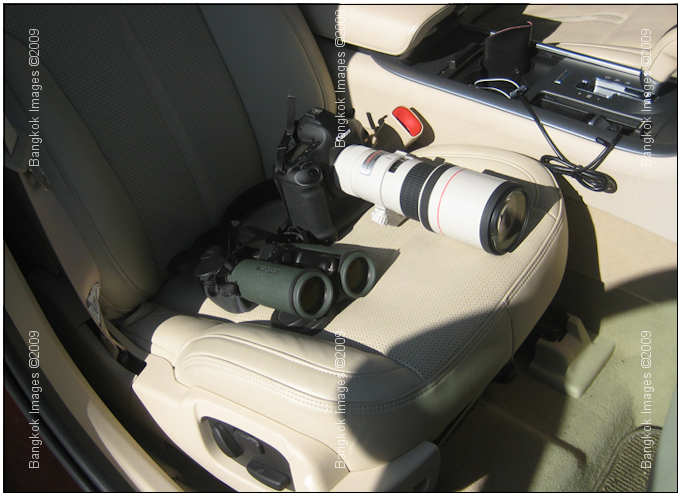
When I drive around I am always ready to shoot because (here we go again)– wildlife appears when least expected
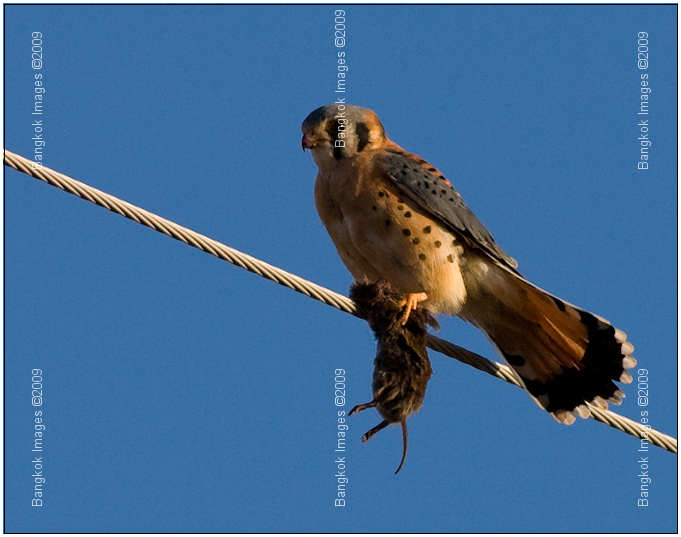
Got this kestrel and mouse on a power line this October while driving around with this equipment on my seat
Canon 1Ds Mark III, SS 1/1250th, Av, ISO 800, f/7.1, Canon 400 mm f/5.6 lens
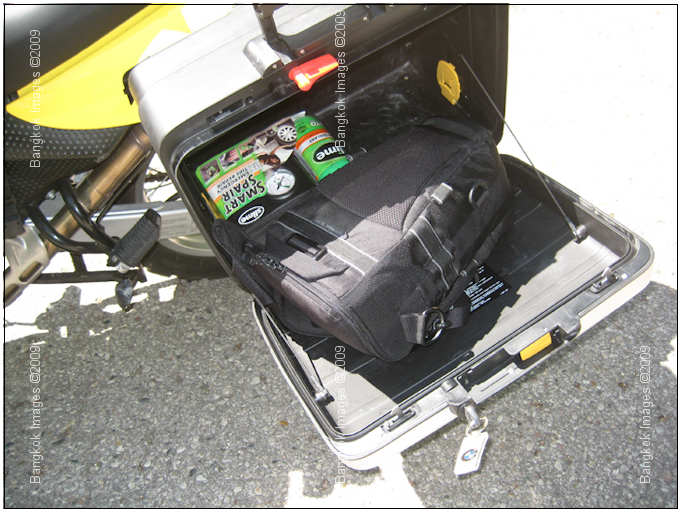
I even bring my camera equipment when I ride my motorcycle. My 1 DS and 24-105 mm packed with my flat tire kit on my left bag
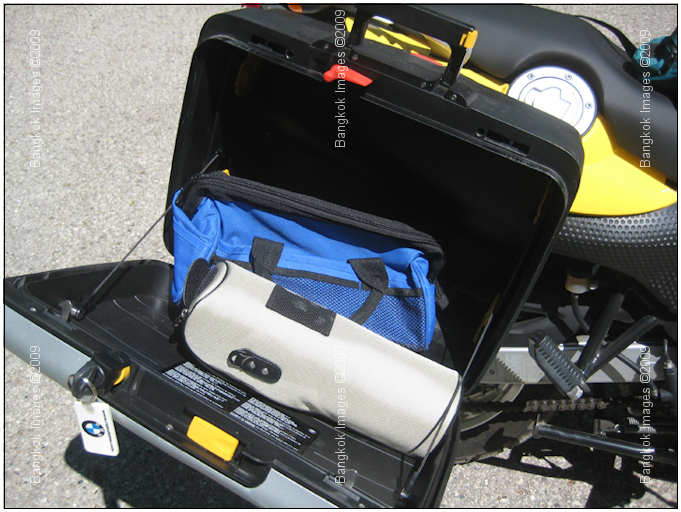
My 400 mm f/5.6 packed with my tool kit on my right bag
Photography is a science and an art just like veterinary medicine. After a significant period of time you have a good knowledge base from which to progress. They both take a commitment to continual learning. Its nice when you can be in the outdoors enjoying
nature while learning at the same time.
What Does it Take
What does it take to get those photos that you will be proud of and will impress those you want to impress? After a reputable safari company the next most important logistic if you want to get good wildlife pictures is patience. Plan on just hanging for
a while, even though it is boring, hot, and the odds of something happening that is of photographic significance is minimal. The more days you are on safari the more often you can just hang in one spot and not feel you are missing out on something
elsewhere. Ten days seems to be a good number.
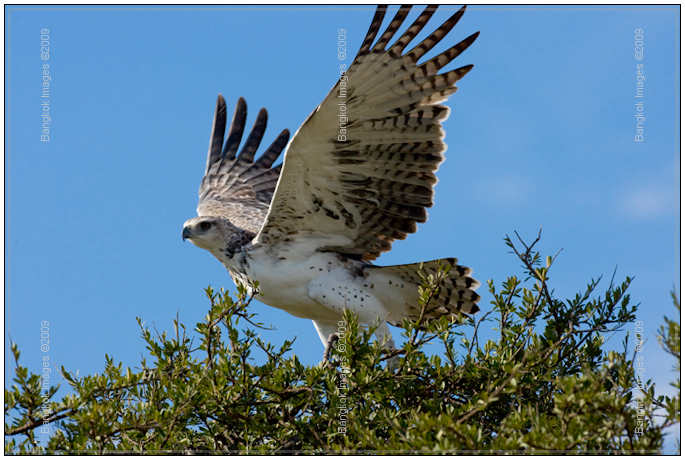
Patience and pre focusing let me capture this martial eagle as it exploded out of its nest
Canon 1D Mark III, SS 1/1250th, Av, ISO 400, f/8, 500 mm f/4 IS lens
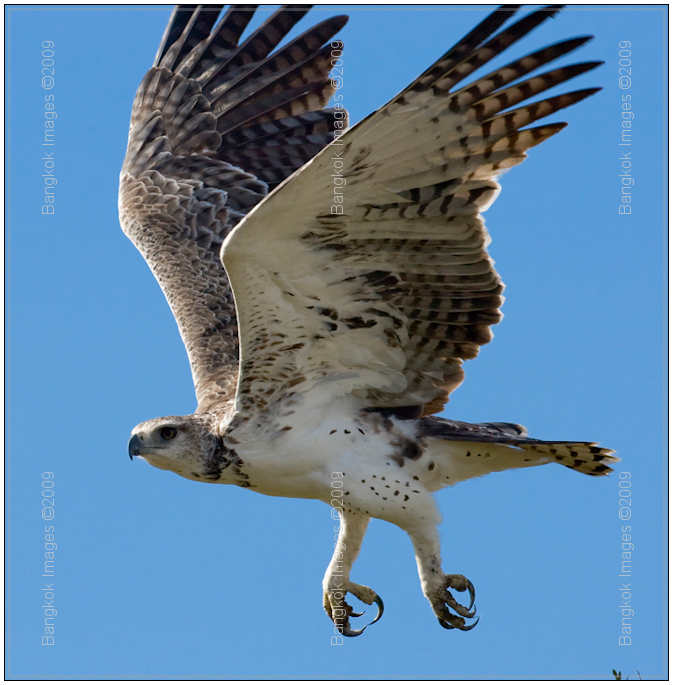
Canon 1D Mark III, SS 1/1250th, Av, ISO 400, f/8, 500 mm f/4 IS lens
You need to be out in the bush to see wildlife, not back at camp or in your hotel room. You need to be where the wildlife congregate at a particular time of year, or where the predators hunt and defend their territory. You need to understand the behavior
of the wildlife you are observing to anticipate their next move and capture it on your camera. Africa is alien territory to most of us, so we cannot accomplish all of this on our own. A reputable safari company with good guides does all of this
for you.
Even though I am a big advocate of pacing yourself and resting when you can at the beginning of what is usually a long and exhausting trip, once you have your stride you need to be out in the field to see the action.
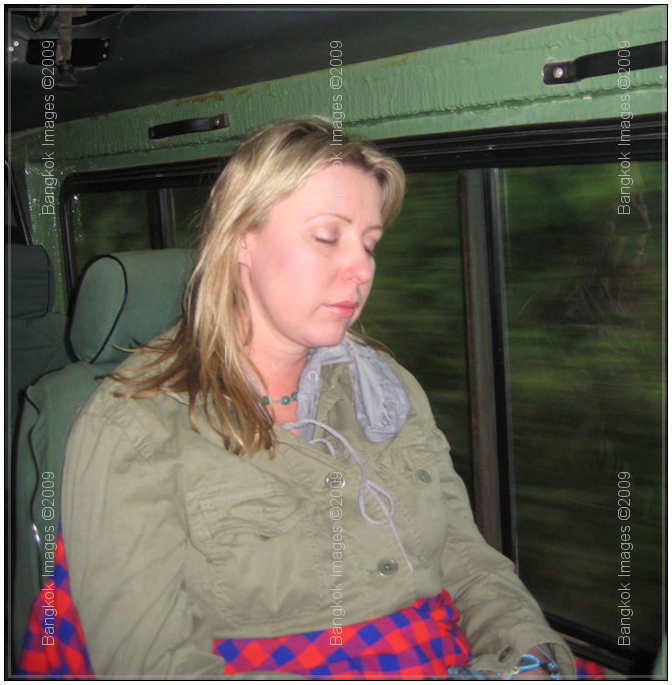
These trips can be exhausting, especially if you drive to numerous National Parks. Grab a few minutes of shut eye whenever you can
I remember the disappointment some guests had in the Masai Mara when they slept in on their last day and were not up early for a final game drive. They missed a Topi giving birth 20 yards in front of us.
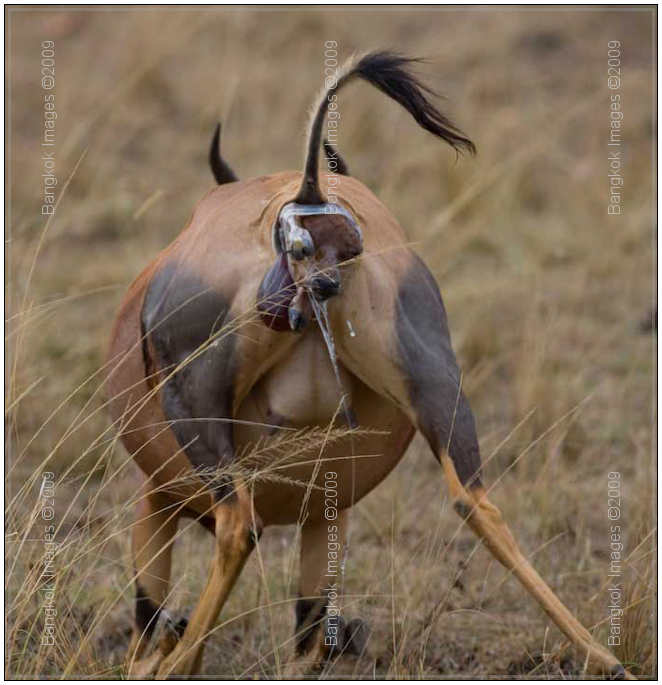
Sean and I saw the full monty on this one. Here are just three of the 99 I took
Canon 1D Mark IIN, SS 1/250th, -2/3 EV, Av, ISO 200, f/5.6, Canon 500 mm f/4 IS lens
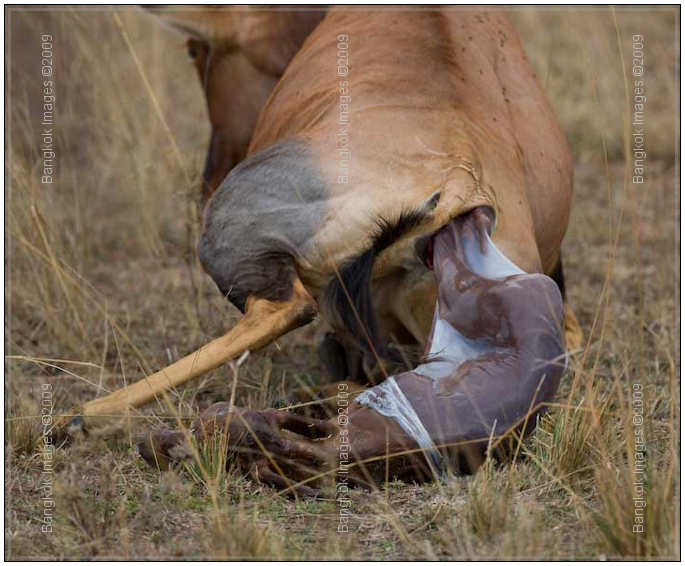
Canon 1D Mark IIN, SS 1/320th, -2/3 EV, Av, ISO 200, f/5.6, Canon 500 mm f/4 IS lens
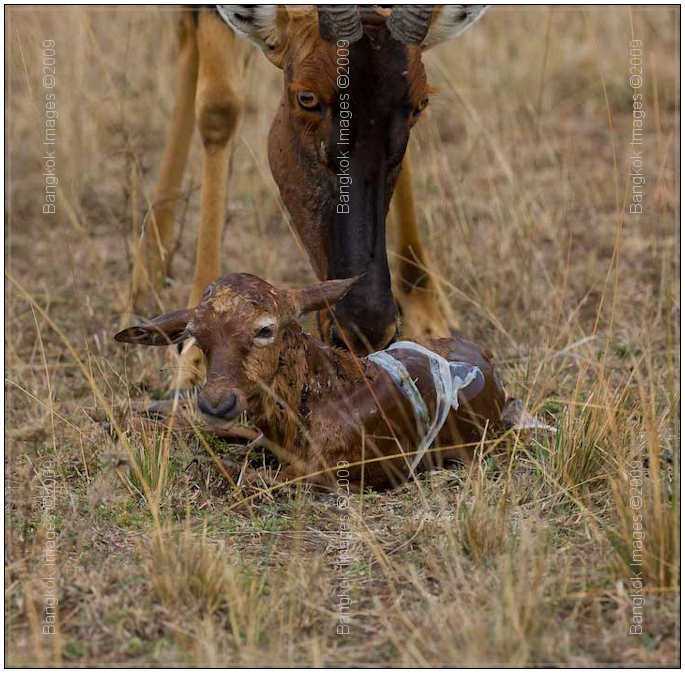
Canon 1D Mark IIN, SS 1/500th, -2/3 EV, Av, ISO 400, f/6.3, Canon 500 mm f/4 IS lens
You will be on or very near the equator. There are no seasons like we are used to, so sunrise and sunset are consistent. Most game drives leave your camp or hotel around 6:30- 7 AM AM, return late morning or early afternoon, then go out again around 4
PM until it gets dark. Unless you are involved in a special research project, or are in a conservation area and not a National Park, you have to be back at dark. Ask your guides if you can eat lunch in the field and stay out, as long as you can
take the midday heat.
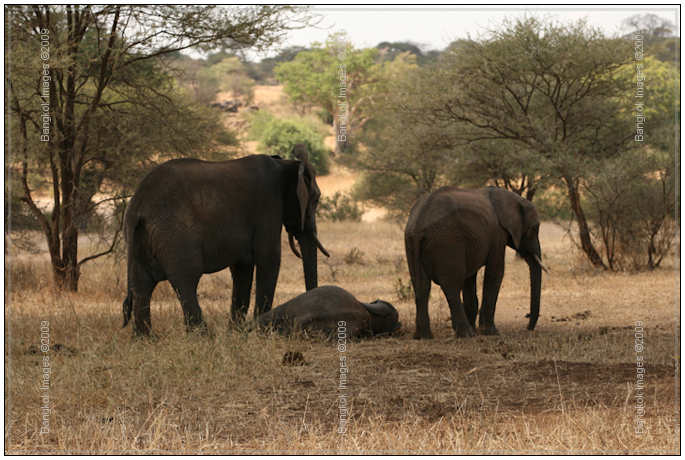
Yes, even the animals rest in the middle of the day
Canon Rebel XTi, SS 1/1600th, ISO 400, Av, f/4, Canon 70-200 mm f/4 @ 109 mm
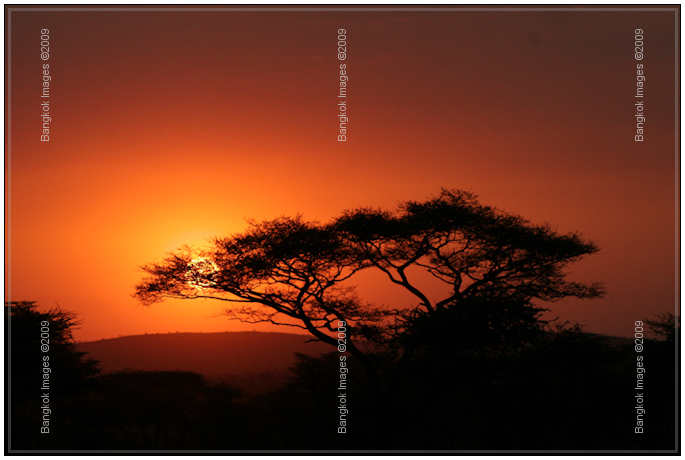
You will be out as the sun is coming up and when it is going down. There might even be some good sunsets to grab
Canon 20D, SS 1/1250th, -2/3 EV, ISO 800, Av, f/6.3, Canon 75-300 mm lens @ 130 mm
Much is written about shooting early and late for the best lighting. Good luck getting the wildlife to pose for you then. It does happen, and you might need a flash in the lower light, so by all means take advantage of the good photography light. But
don’t stay indoors at midday and miss a cheetah (they tend to be daytime hunters) hunting its prey just because of the harsh shadows and someone somewhere says you should only shoot wildlife
early land late because of the better lighting.
Many times the wildlife will be resting in the shade due to the heat, but then again they might not be, and how often are you going to get a chance to get those special photos. That special moment happened on my 4th trip, and by staying out in the noon
heat I was able to take hundreds of photos of two juvenile cheetah’s toying with a baby Thompson’s gazelle.
These are yearling cheetah practicing their skills on a Thompsons gazelle that is only a few days old. Its an example of natures beauty and brutality all at the same time, and something that has been going on long before we started photographing it.
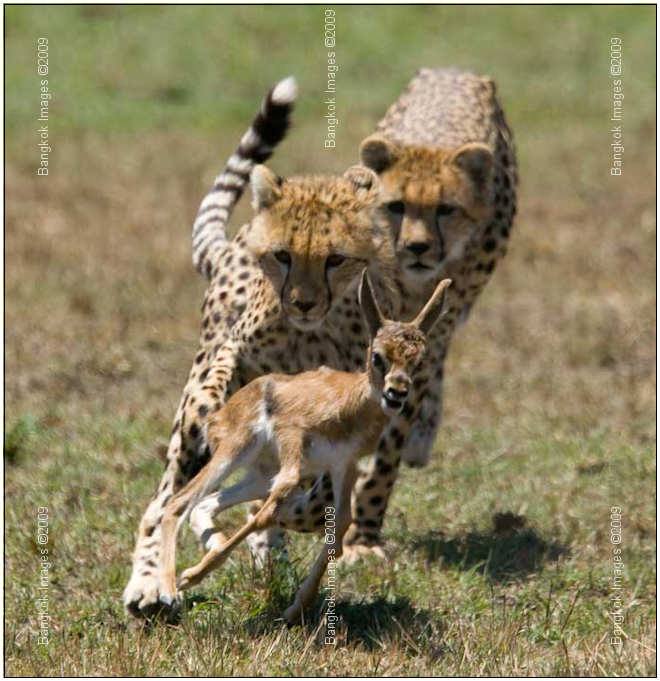
Keep in mind the cheetah is much more endangered than the gazelle. I took hundreds of photos of this, many of which you can view on my web site
Canon 1D Mark III, SS 1/100th, Av, ISO 400, f/7.1, Canon 400 mm DO lens, 1.4X TC
Many big cats are in danger of extinction. At the end of this page I have a link to an L. A. Times November, 2009 article referring to Derek and Beverly Joubert on their Big Cat Initiative and how perilous the situation is for the big cats of the world.

After walking 6-8 hour transects in that hot Zimbabwe sun everyone was crashed on the ride back to camp. Everyone but me, observing from the open roof as my shadow will attest. I didn’t want to miss a thing. You can sleep when you get older
I am constantly testing shutter speeds based on my ISO and aperture. I take test shots by the shadows of the tree to see my exposure. I prefocus (I did this on the martial eagle I showed earlier) on some
spot that looks like it should have wildlife just in case one appears near the area and there is no time to focus. I scan the sky to see if clouds are coming to lay shadows on the terrain. I stay proactive and ready so I can be ready for anything
Practice before the trip with varying lights and subject distance, maybe even using a practice bean bag setup, and you will have important background information (how much noise at a given ISO, etc) as a
basis for those sometimes fast decisions you need to make out in the bush.
Most people are too busy to do this, or tell me “I learn by doing”, and think they can catch on to all of this easily when the action starts. Fat chance of that in the field. By practicing
ahead of time, even with consumer grade cameras and lenses, you can take better photos than people that bring expensive professional level equipment and have yet to perfect their technique. If you are reading your camera manual on your flight
then you have not practiced enough.
Come back next week (December 19th) for Part II



